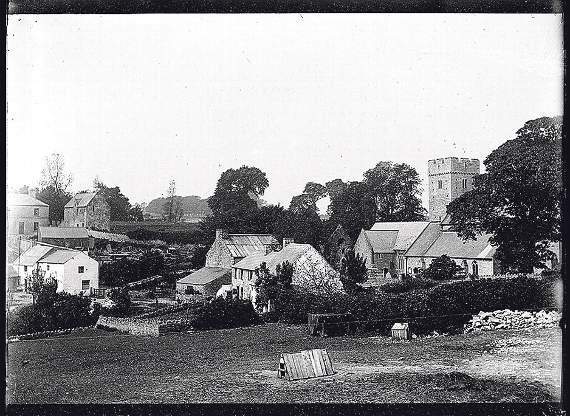The 2023 excavations at Llantwit Major
(scroll down for the blog)
2024 blog now available here.
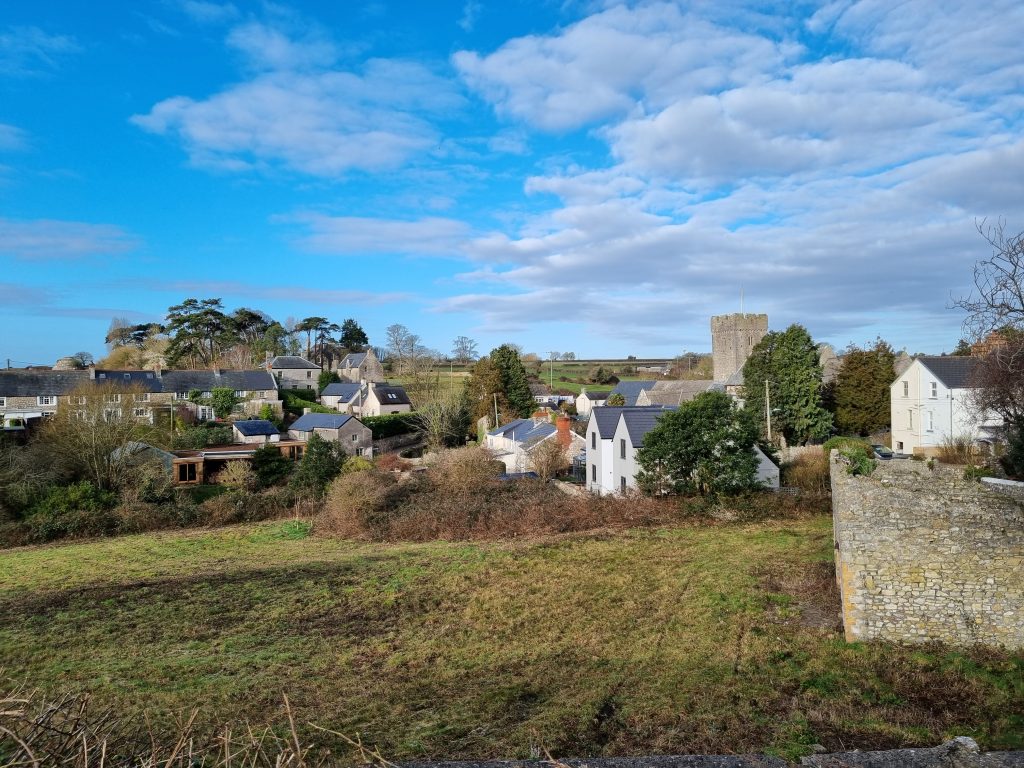
The 2023 Cardiff University excavations at Llantwit Major will be running from 21st August until 15th September. The main trench is sited in the ‘Globe Field’, so-called because it was previously owned in conjunction with the former ‘The Globe’ pub.
The field lies just to the south of Llantwit Major church, which is generally believed to be on or near the site of an important early medieval monastery associated with Illtud (or Eltutus) who lived in the late 5th to early 6th century. His pupil, Samson, travelled in what is now France and was a signatory to the Synod of Paris in c.568. The monastic centre rose to prominence in the subsequent centuries, with Samson’s biographer describing it as ‘magnificent’ when he visited (probably in the late 7th century). From the late 8th to the early 10th century, the heyday of the site saw it become a royal burial ground and the wonderful inscribed stones, now displayed in the Stones Museum in the church, were erected. The centre decreased rapidly in influence during the 10th century and c.1100 the remnant properties of the clas church were gifted to Tewkesbury Abbey by Robert Fitzhamon after the Norman invasion. Tewkesbury Abbey’s facilities for the collection of tithe and management of the estate include the dovecote and gatehouse of the 13th century, still visible on the hill to the west of the church.
The present archaeological work forms part of the ‘Dr D.G. Smith Memorial Project’ which is intended to increase understanding of the early medieval monastery at Llantwit. This project has entailed extensive geophysical survey of relevant areas around Llantwit, together with a reappraisal of the historical evidence. Out of this, a working hypothesis of the possible extent of the monastic enclosure of the 7th-10th centuries has been developed. Geophysical survey in the Globe Field has produced evidence that suggests one of the subdivisions of the enclosure underlies the field. The 2023 excavation’s main trench is sited to test this geophysical anomaly and to test a swathe of ground as close to the church as we can currently investigate.
A second component of the 2023 season will be test-pits on the western side of the valley to investigate the extent of early medieval activity there.
We are very grateful for permission to excavate from the various landowners involved and for the continued support of the ‘Dr D.G. Smith Memorial Project’.
Resources for participants
The following resources may provide useful background information for participants:
- Research design for the 2023 season
- Geophysical survey report
- The Vita Prima Samsonis may be found at: https://archive.org/details/lifeofstsamsonof00sams
- An online version of the Life of St illtud (c. 1140) after the version in Vitae Sanctorum Britanniae et Genealogiae. ed. A. W. Wade-Evans. Cardiff: University of Wales Press, 1944. may be found at:
http://www.maryjones.us/ctexts/illtud.html - The Stones Museum leaflet
Other reading:
- Knight, J. K. (2005). From Villa to Monastery: Llandough in Context. Medieval Archaeology 49. Vol 49, pp. 93-107. https://doi.org/10.5284/1071963
- Knight, J.K. (2013). South Wales from the Romans to the Normans: Christianity, Literacy & Lordship. Amberley Pub (ISBN 10: 1445604477 / ISBN 13: 9781445604473)
- Morris, P. (2022). Llanilltud – The Story of a Celtic Christian Community. Y Lolfa. (ISBN-10 : 1784617539 / ISBN-13 : 978-1784617530)
- Nash-Williams, V E, 1952. The medieval settlement at Llantwit Major, Glamorgan. Bulletin of the Board of Celtic Studies, 14, 313-33.
Blog
22/12/23: in what is likely to the last post of the year, I am delighted to be able to share the news of the first two radiocarbon dates – on the two sets of human remains mentioned in my post of 29.9.23 below. A partial rib from infant skeleton (164) has produced a data of cal. AD 700-740 (4.9%)/770-900 (88.3%) / 920-950 (2.1%) (Beta-682558; 1200 +/- 30 BP) and a femur from context (169) gave a data of cal. AD 700-740 (9.5%) / 770-900 (85.9%) (Beta-682559; 1210 +/- 30 BP). In short, both remains belonged to people who lived in the period between the late 8th century and the end of the 9th. This is the heyday of the royal burial ground at the modern church – and is later than the burials on the west side of the valley. This is another important step forward. I hope we will be able to date the metalworking activity in Trench 1 early in the New Year.
3/10/23: trench 1 is backfilled and the topsoil spread. If the speed of growth of the vegetation on the spoil dumps is anything to go by, then this will have returned to nature very soon.
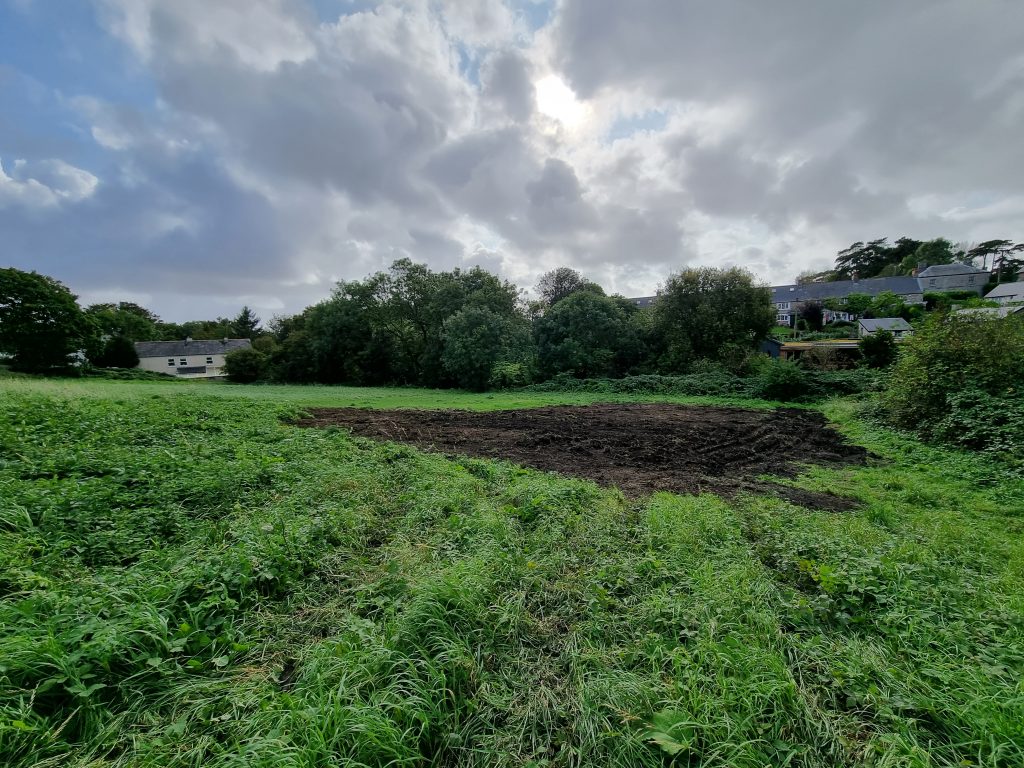
29/9/23: the first stage of backfilling was undertaken today and the rest will follow next week, so today seems like time to catch up on events over the two weeks since the dig ‘finished’. As described in my last post, further work on the northern sondage produced several significant and early features.
Firstly, there was the burial of an infant – approximately 18-24 months old we think, subject to the proper osteological work to be done shortly. The grave was aligned approximately SW-NE, with the head at the SW.
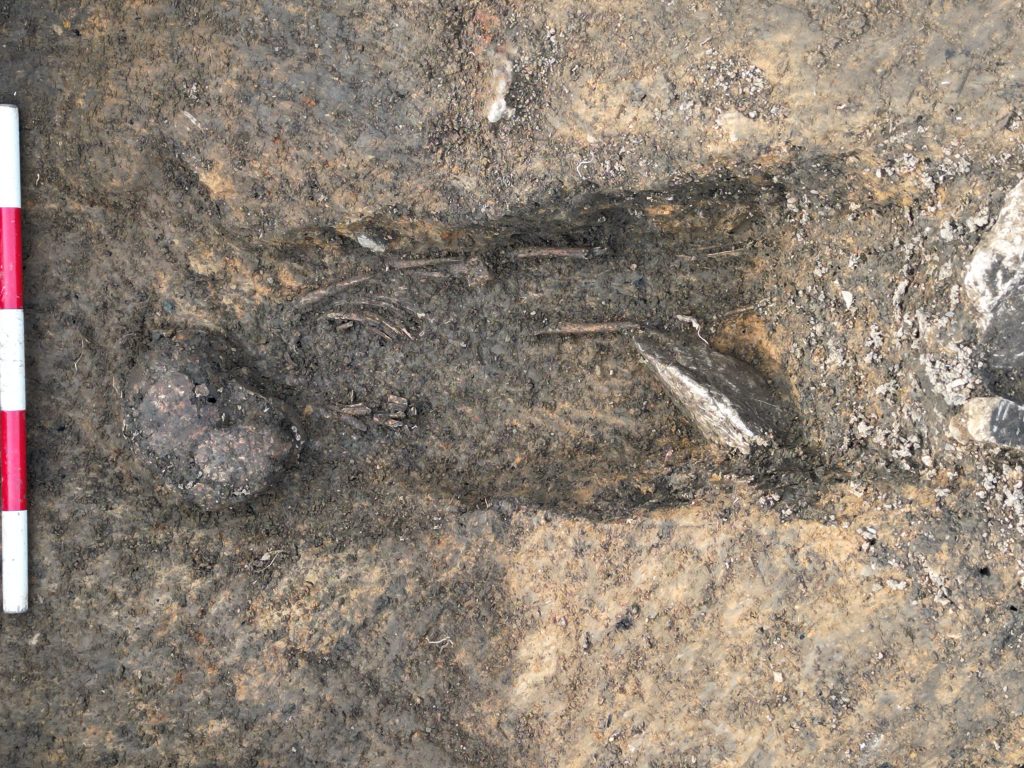
Secondly, less than 2m to the east of the grave there was a metalworking hearth. This was probably mainly for the smithing of iron, although there was some evidence for the working of copper-alloy in the general area. The hearth was a small (550x750mm) clay-lined bowl, originally blown from the SE side. Both the burial and the hearth (together with several nearby postholes and stakeholes) were overlain by the dark slag-rich soil that underlay the stone walls.
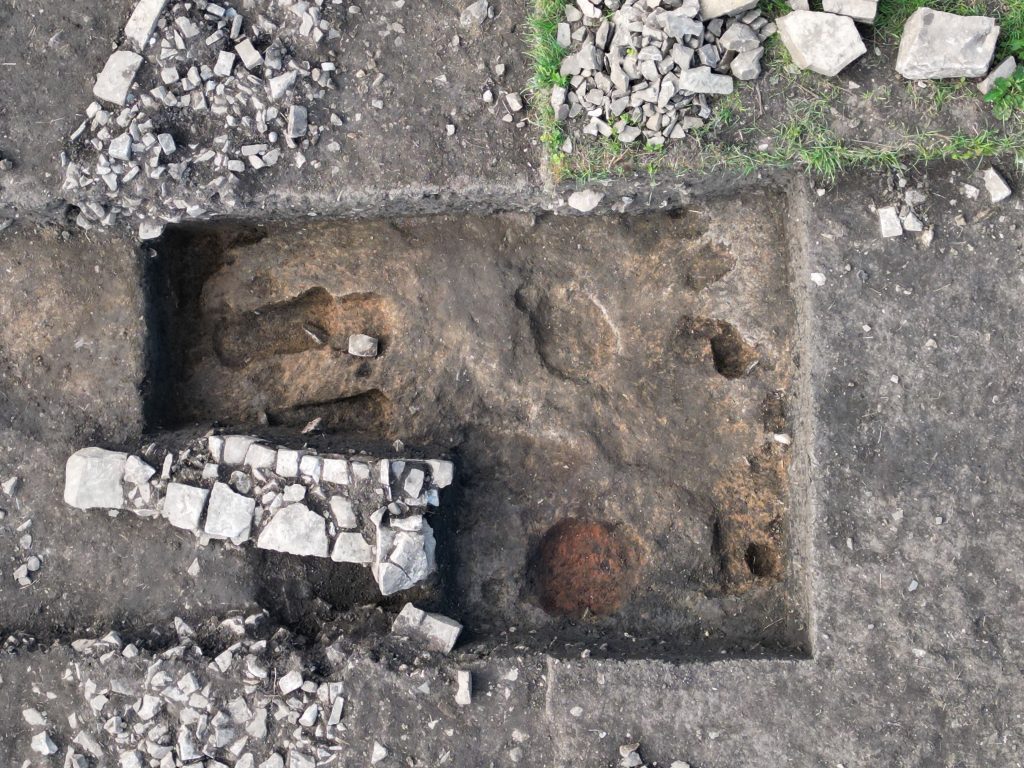
Whilst work progressed on the northern sondage, we decided to pursue the southern one further too. The sequence below the stone wall was very different here. The thick sequence underneath the wall is currently interpreted as a formerly wet area including some very minor channel-like features. The difficulty that we had in locating the natural in this sondage seems to be caused by its surface locally being heavily poached, presumably by the feet of farm animals, when it was wet and soft. To counter this, several discrete dumps of stone had been dumped onto the edgse of the channel. That water flowed in these channels, at least on occasion, was suggested by horizons of flat limestone pebbles. Upon one of these pebble layers were two human femurs, end to end, and apparently aligned by the flow of water.
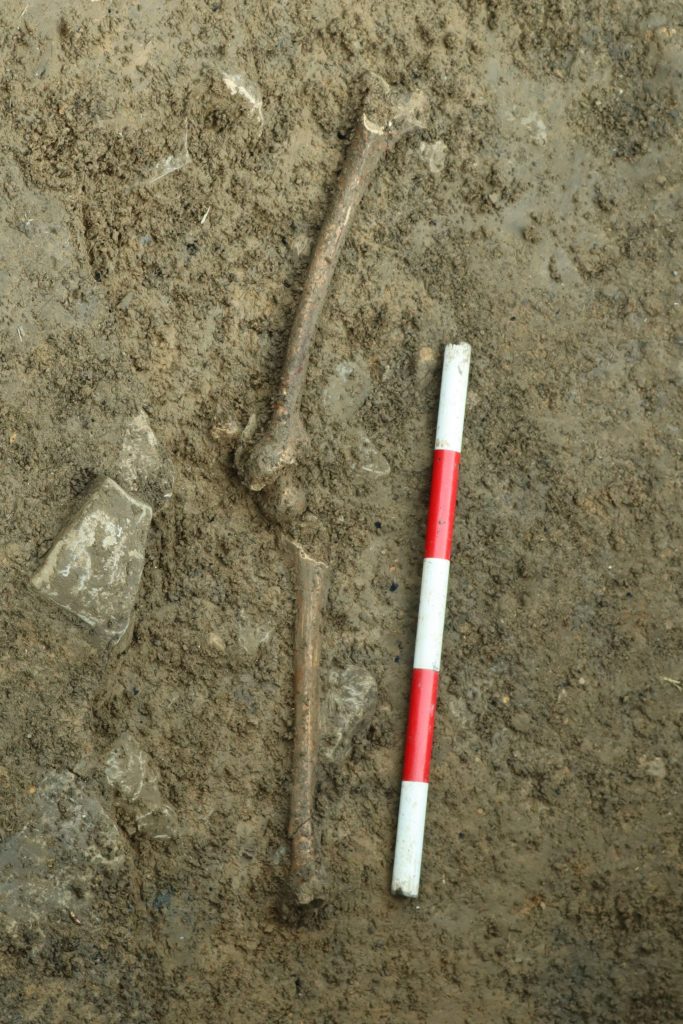
Determining what all this means is going to be a slow process over the coming months, as we first process our samples to look for suitable materials, and then obtain radiocarbon dates. At this stage, it provisionally appears that there were three distinct phases of early medieval activity: the earliest with both burial and metalworking in the north of the trench, but with an intermittently wet area at the south end, a second with a build-up of dark soils across the area whole trench, possibly indicating cultivation, and then a third phase with the area sub-divided by stone walls, the use of which appears to have continued as late as the 13th century.
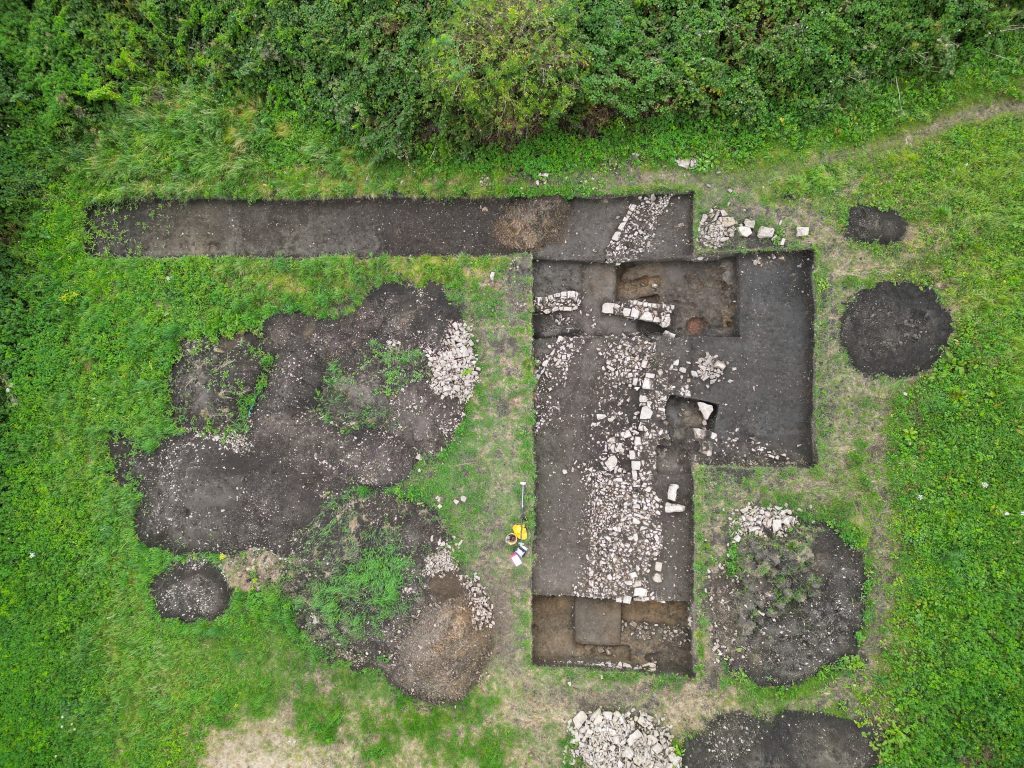
18/9/23: a small group were on site today to do the final bit of recording and to prepare for the backfilling. It didn’t quite work out that way. The wetting of the whole site by the weekend’s rain allowed the soil colours to show much better – and it quickly became clear that there were suspect areas in the northern sondage. A quick trowel of the most prominent produced a nice metalworking hearth and there are probably other features too. The backfilling is now postponed…
15/9/23: the last day of the excavation was as busy, frantic and full of unexpected things as last days always are. It has been a very productive four weeks – not only did we find the wall we were looking for, but multiple walls defining part of a field system. The lynchet that accumulated along the N-S wall preserved the history of its formation passing back through the medieval period into aceramic deposits. Those early deposits produced evidence for extensive metalworking, mainly of iron but with some copper alloy work too. Some possible evidence for glass working may also have been found. Most surprisingly, the earliest phase of soils with metalworking residues underlay the walls of the field system entirely.
To the south-west of the main site, trench 2 also produced good results, with evidence for burials, even if they had been disturbed by later activity.
More surprisingly, sharp eyes watching the finds coming out of trench 1 spotted some human remains there too – with several bones and at least five teeth. These may suggest that the medieval agriculture on the east side of the valley may have disturbed burials there too.
Of course, we won’t know how old any of these things actually are until the post-ex programme produces its results. I will report on progress in due course.
Finally, it just remains, for now, for me to thank all those who have taken part in the years work – the supervisors, the Cardiff undergrads, the volunteers from Cardiff, those from further afield and those from Llantwit itself; those who dug, those who processed finds (including persevering with scrubbing all that slag!) and those who supported us in other ways – with particular thanks to the landowners for their permission to undertake the work. Thank you to you all! You have all been fantastic to work with!
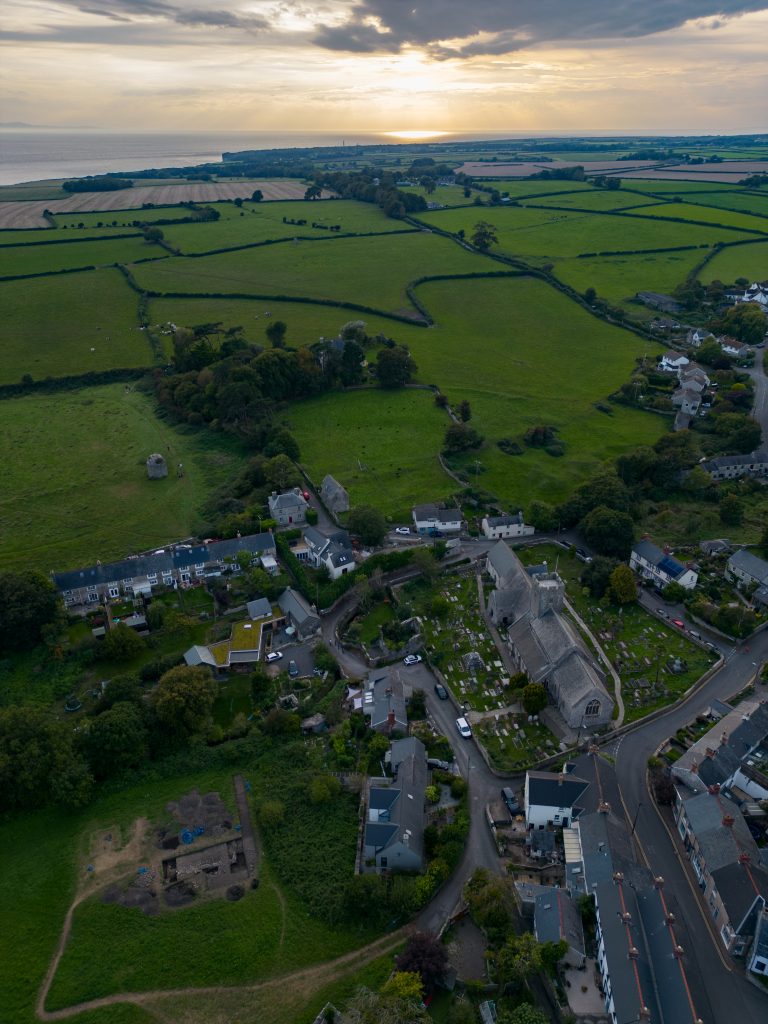
The sun sets down the Bristol Channel at the end of the last day of the 2023 excavation. To the west of the site and church lie the surviving dovecote and gatehouse of Tewkesbury Abbey’s rectory, overlying an earlier field system, the fields that formed the core of the monastic estate, and then the cliffs around St Donats and the Nash Point lighthouse. In the far distance the N Devon coast is visible.
14/9/23: work today suffered from the distractions of backfilling trenches 2 and 3, as well as managing the safe return of the security fencing that had to be carried back up into the village centre for collection.
In trench 1, we concentrated (during the remaining time) on further reducing the eastern part of the northern sondage, removing the east-west wall in the central sondage and on examining the deposits below the north-south wall in the southern sondage. None of these tasks was completed, but progress was made.
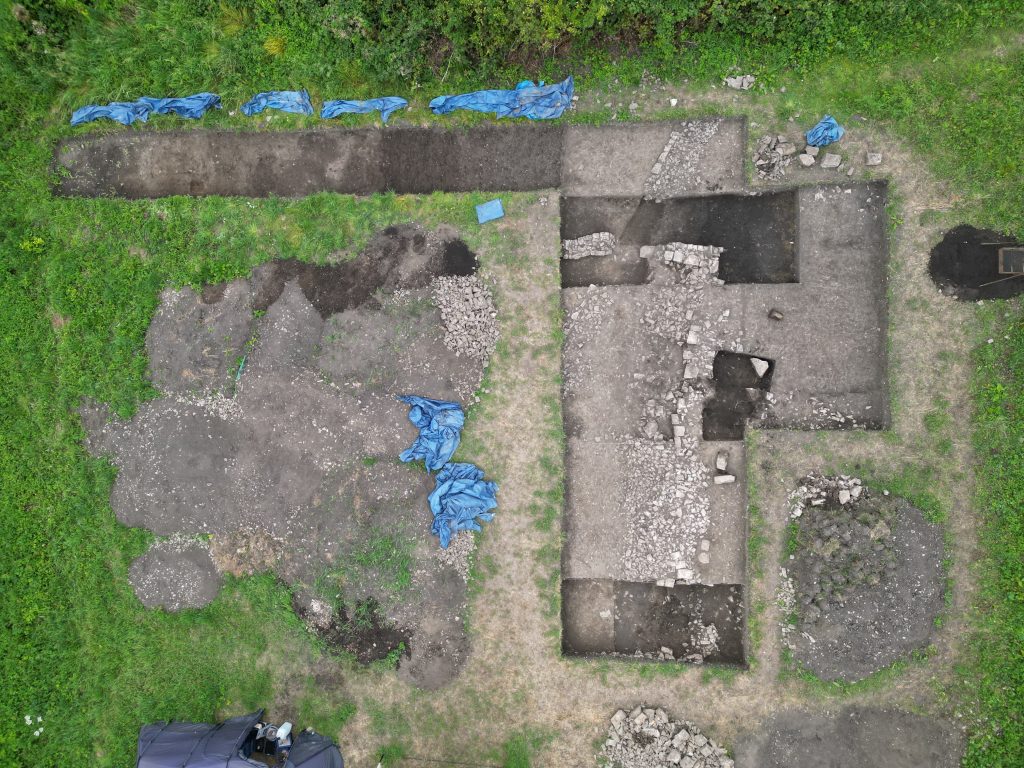
13/9/23: digging was concentrated on three areas in trench 1: the northern and southern sondages and a new central area (with areas taken down either side of the wall running uphill. In the northern and southern sondages the north-south wall was removed, to permit sampling beneath.
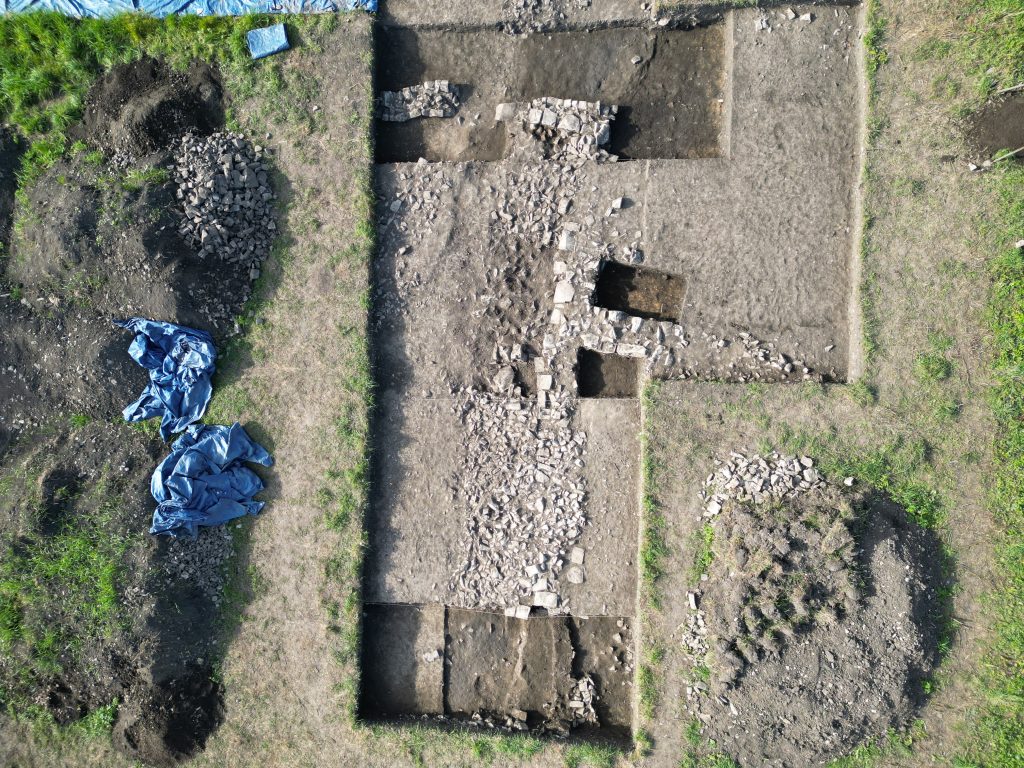
The two faces of the north-south wall in the southern sondage proved to have separated, with the eastern more or less coherent but the western had slipped downslope, so that a lot of fine soil had filled the gap between the two. The wall is shown from the north-east below before its removal. Provisionally, the stone rubble dipping downslope from the wall overlies deposits with pottery of not later than the 13th century suggesting early degradation of the structure.
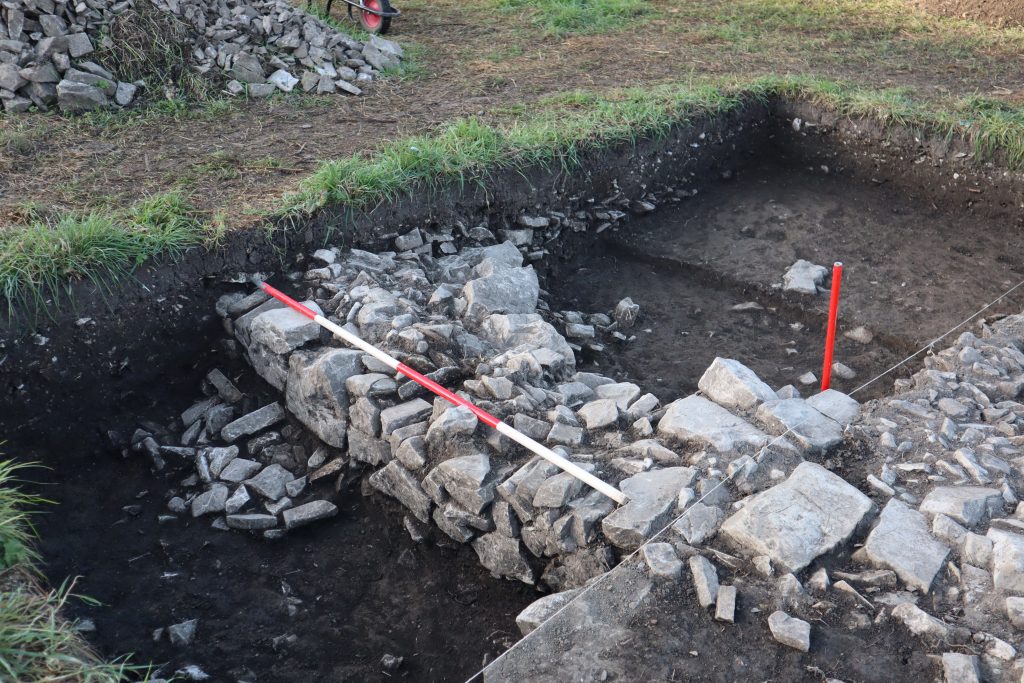
12/9/23: there was great progress on both the trench 1 sondages today. In both sondages the base of the drystone walls can be seen, and in both the surface of the disturbed natural (presumably) can be seen. In the southern sondage the situation looks a little complicated, and there appears to b a considerable height difference in the agricultural soils across the line of the wall. In the northern sondage, the succession appears simpler and the narrow drystone walls there appear founded 200mm above the natural – so they do not belong to the earliest phase of cultivation. More will be revealed tomorrow, as the walls are taken out.
Trench 3 is now down to natural and there was no significant archaeology.
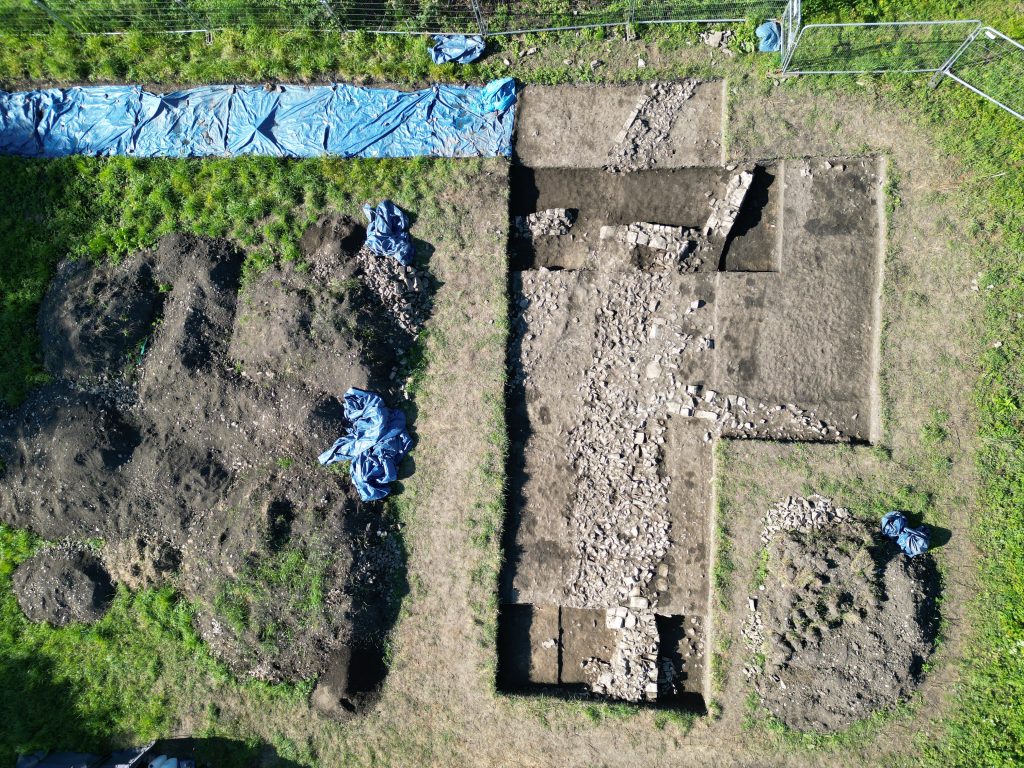
11/9/23: its hard to believe we are into the last week and there are only a couple of digging days left.
Trench 1 made good progress in the northern and southern sondages. In the northern, the stone fill of the drain is now almost removed, the east-west wall largely exposed and the dark soils to the east of the north-south have been bottomed. The lower part of the dark soils only produced some very rare fragments of samian ware – which is promising.
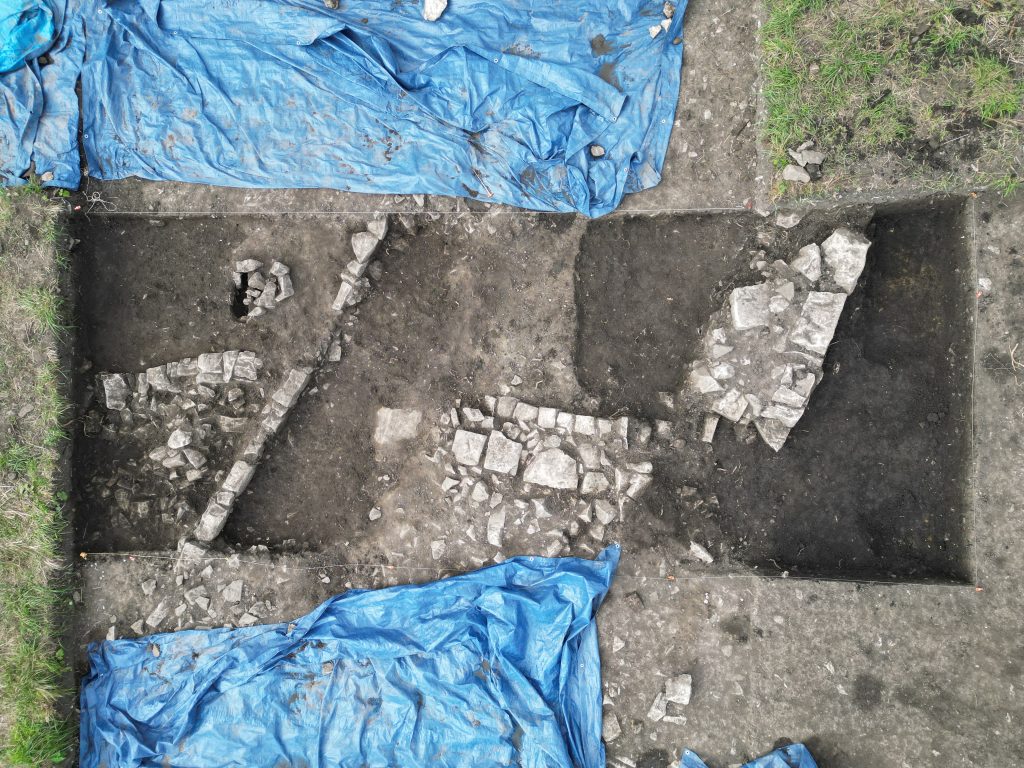
In the southern sondage, the area east of the north-south wall shows similar dark, potentially early medieval cultivation soils (13th century pottery at the top of the layer, no pottery at the base) resting on either a layer with reworked lumps of natural clay or stony material. To the west of the wall, the wall collapse lies on a layer rich in 13th century local pottery, which in turn seems to overlie a deposit rich in charcoal.
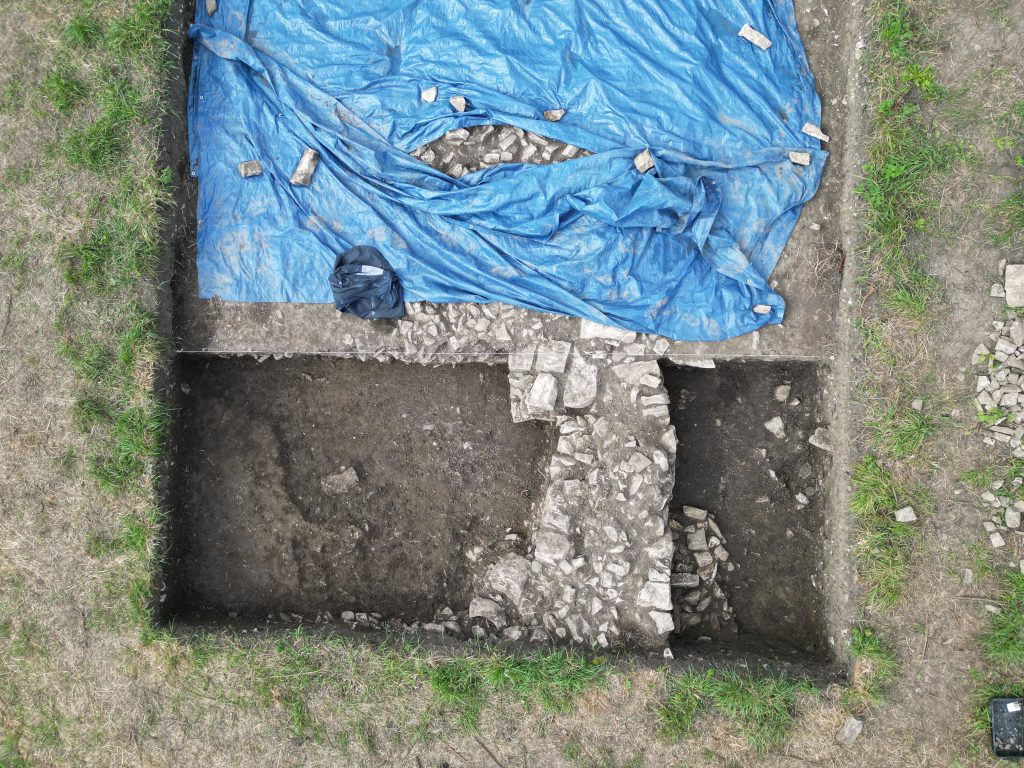
9/9/23: today’s ‘open-day’ was busy – so busy I forgot to take any photos (so the one below is one of Geoff’s)! Approximately 120 people came onto the site and saw what has been achieved so far. Explaining the project many times over only reinforced quite how much there is still to do in the next few days. Thank you to all the project team, especially the volunteers, who worked so hard in the heat to make it a successful day.
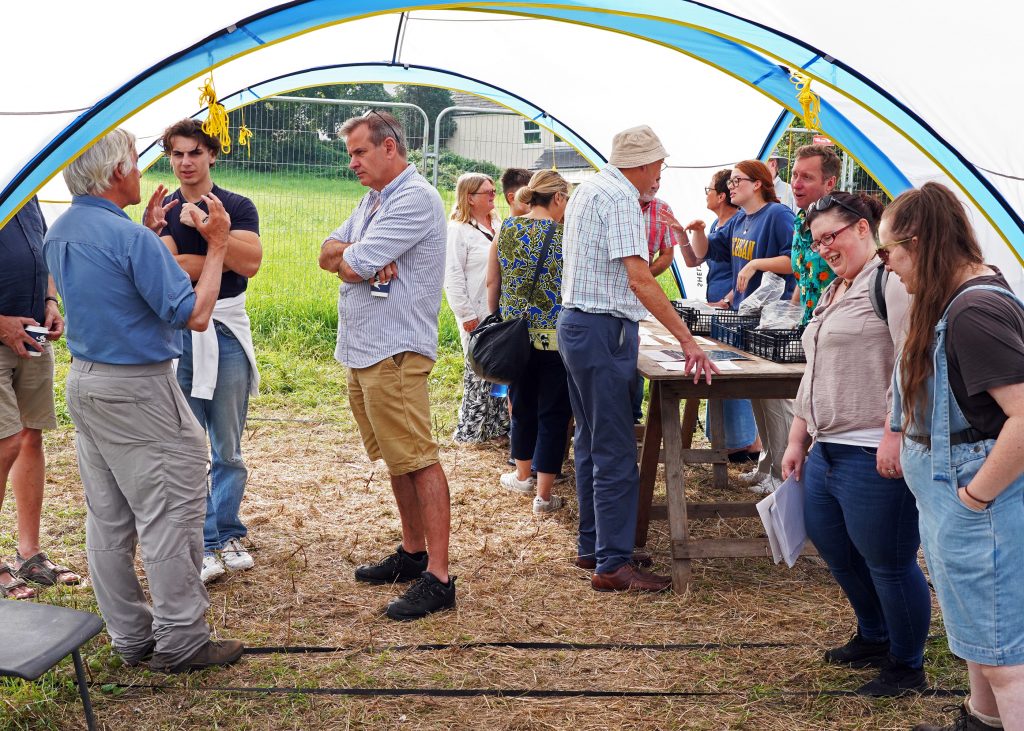
8/9/23: with trench 2 almost wound-down, a larger team could be thrown at trench 1 today. Both northern and southern sondages made good progress. The deposits east of the main North-South wall are similar – and apparently early, yielding lots of slag but almost no pottery. W of the wall in the South the level of excavation is still producing plenty of 13th or 14th century pottery.
West of that wall in the northern sondage, work is still at a higher level. The stone feature here previously interpreted as the field boundary on the Tithe Map is now looking much more like a drain (which presumably ran alongside the field boundary) – and this cuts a wall running west from the main north-south wall.
Tomorrow, we will be welcoming visitors to the site between 10:00 and 4:00 – and after that we will be into our final week, still with much to do!
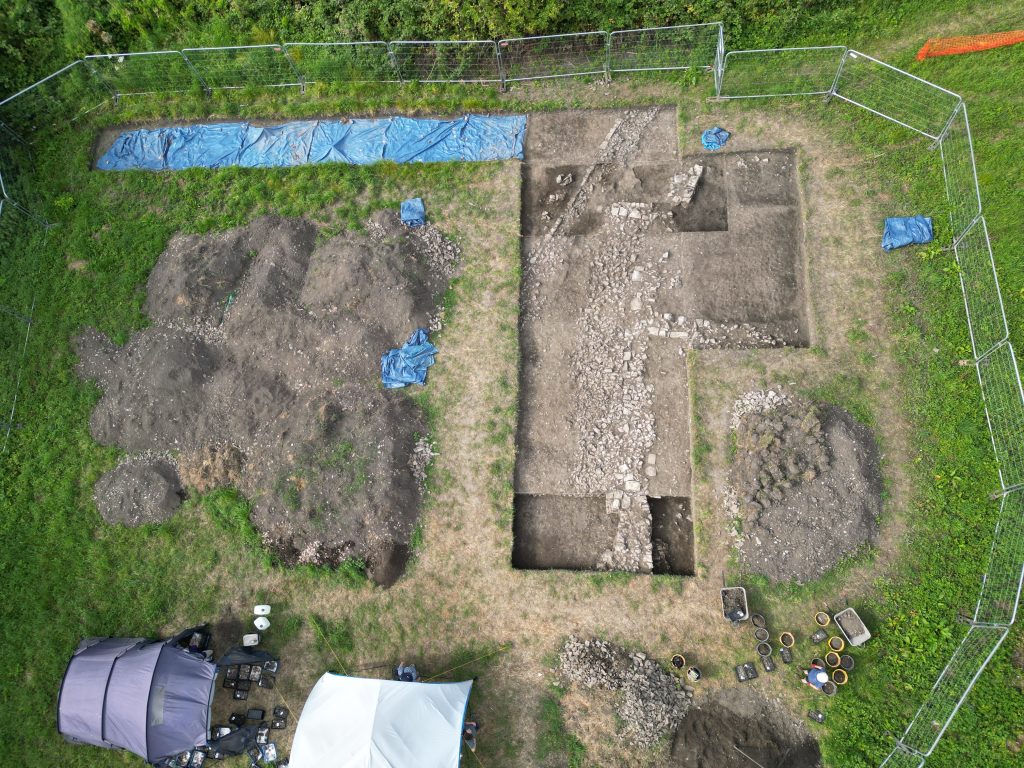
7/9/23: the promised blue sky never came – the day however remained very hot and extremely humid with occasional large drops of rain full of Saharan dust. The students on trenches 2 and 3 received instruction from Steve on recording with only a small amount of fresh excavation.
Our osteoarchaeologist, Bethan, visited today and gave her initial thoughts on the bones from trench 2. It seems they are likely to include bones from both a young child and an adult.
In trench 1 work continued at both the north and south ends. In the north the various short lengths of wall are continuing to be a challenge to interpret. In the south the wall is slowly making sense – the west face shows extensive collapse and rotation of the lowest visible blocks, the east face is lightly curved and now appears to overlies deeper stonework. The west face in the area we have excavated is not in-line with the apparent face just visible through the overlying stones just a few metres to the north. One possible explanation for this, which we must now test, is that the entire wall in the are of the sondage has been pushed westwards, downslope, by the weight of the lynchet to its east, so that the upper courses of the wall (yellow) have been displaced westwards over the lower courses (orange) by perhaps 400 or 500mm.
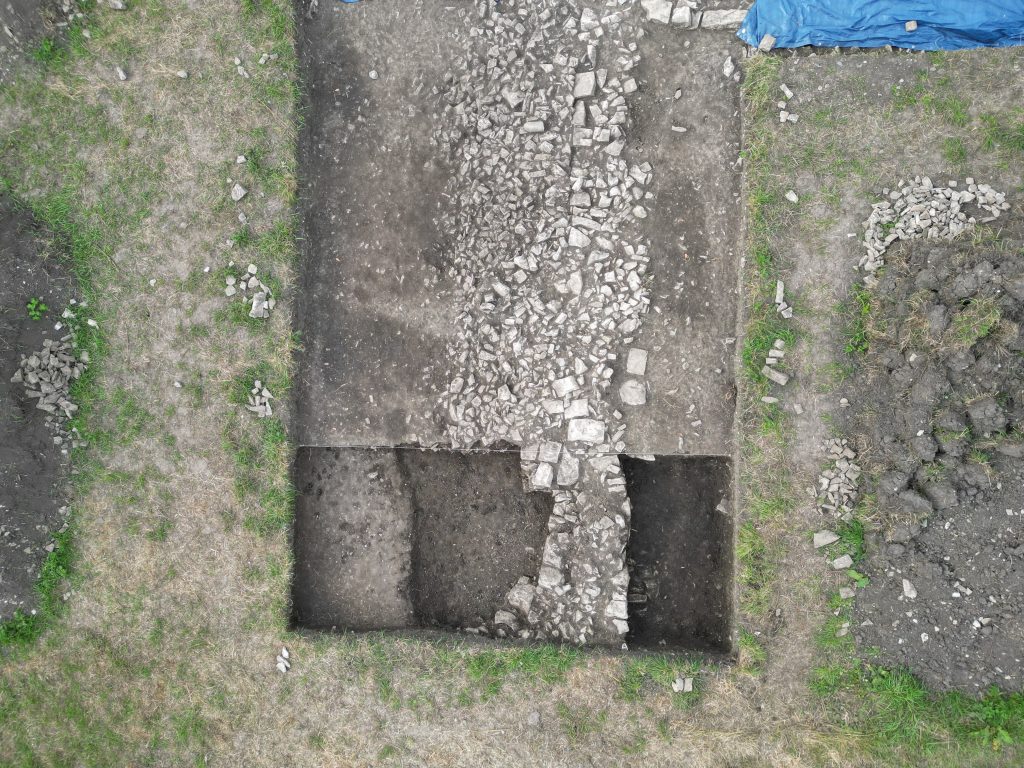
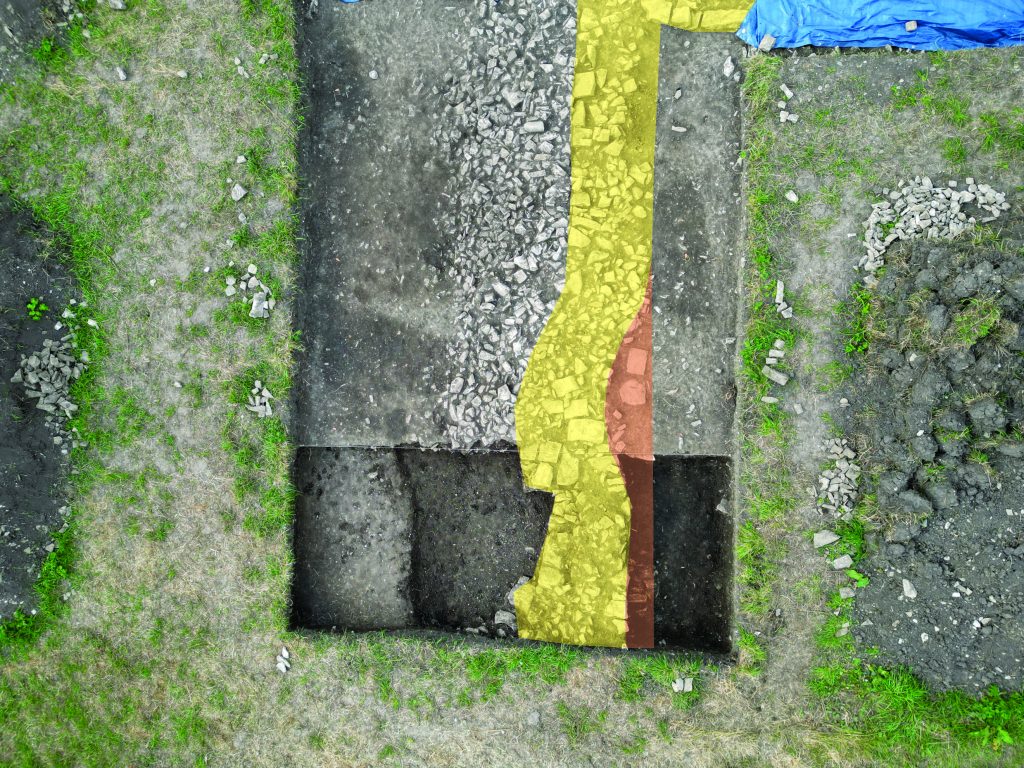
6/9/23: it was another very hot day, so one of the covers was moved over the end of trench 1 to give some shade. Work continued on exposing the wall at the south end of the trench, but it seems the west face had collapsed in that area.
To the north, some tentative investigations were started around the complicated area with multiple walls, but the trench was too short-staffed today to make great progress (four of the team were off today).
Trench 2 appears to have more or less completed to natural, just leaving some recording for tomorrow and trench 3 has arrived at disturbed natural only just below the topsoil.
It was very busy day for site visitors! The process of advertising our informal open day on Saturday has begun – with visitors invited to see the site between 10 and 4.
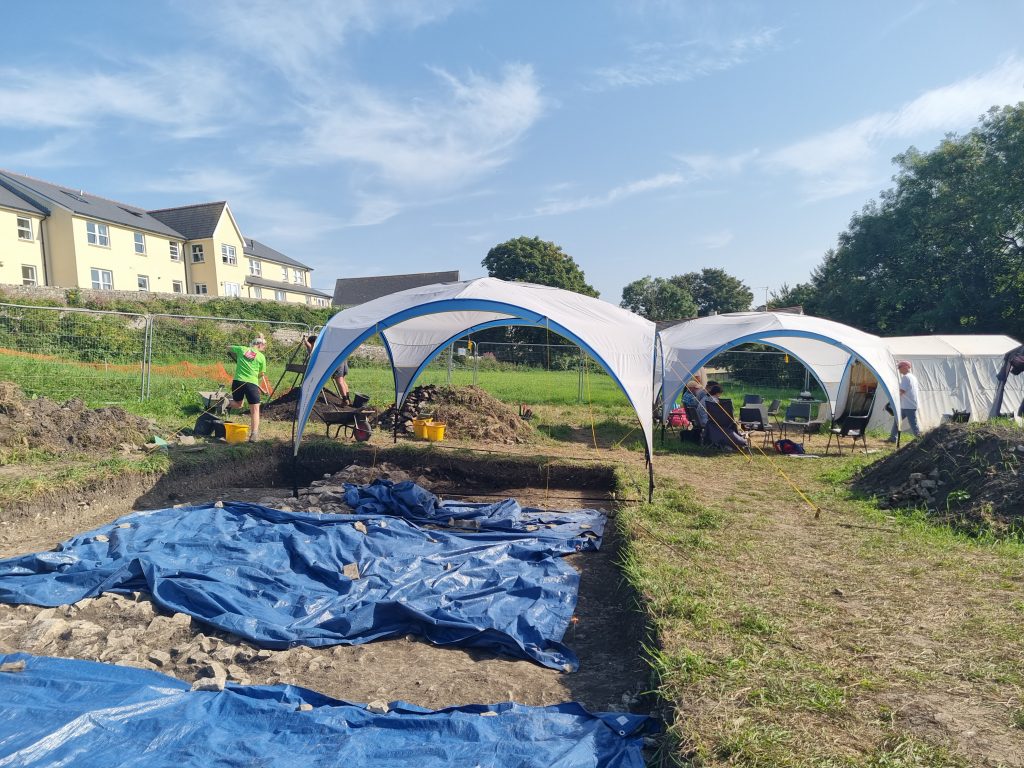
5/9/23: with the cleaning finished, work started on the first of a series of targeted sondages in trench 1. To the west (left in the aerial image) the stone rubble dropped away and became rather sparser. To the east (right in the aerial image), the upslope side, a sequence of dark soils has accumulated against the wall. This sequence is effectively a lynchet – and is precisely the sort of accumulation that we hoped to find here. The work was undertaken with a small team as both trenches 2 and 3 were active today. Trench 2 produced some more disturbed human bones and Trench 3 has been begun, but is not yet down to ancient levels.
We had an excellent turn out of volunteers to join the finds washing team today – thank you so much for your efforts!
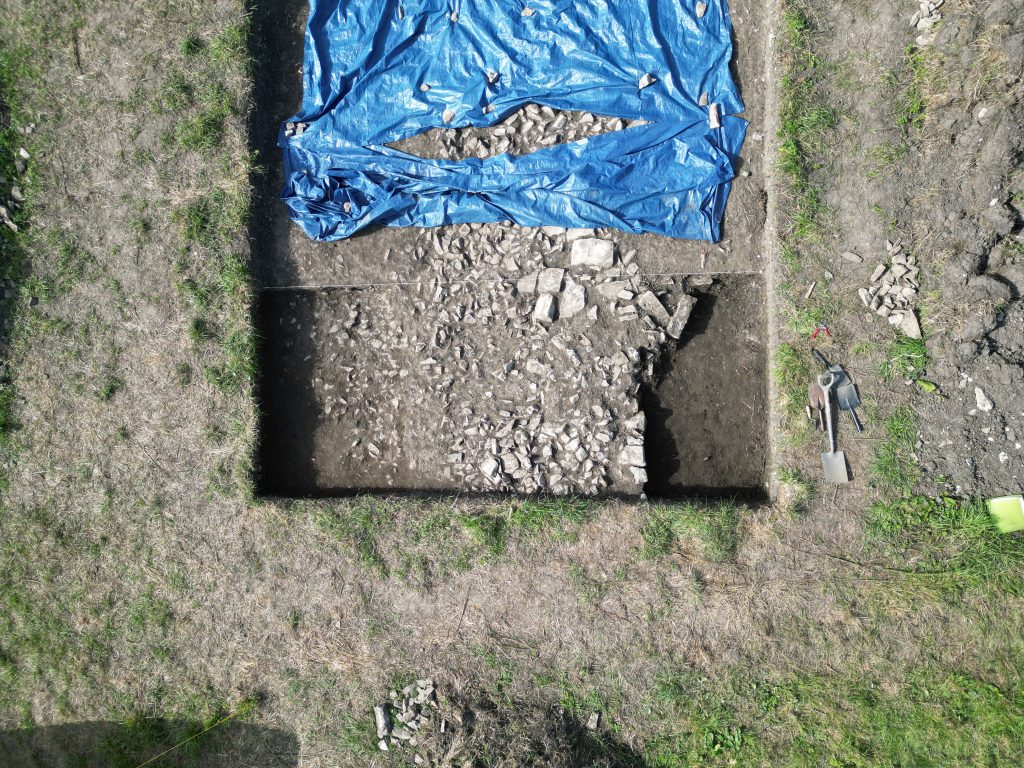
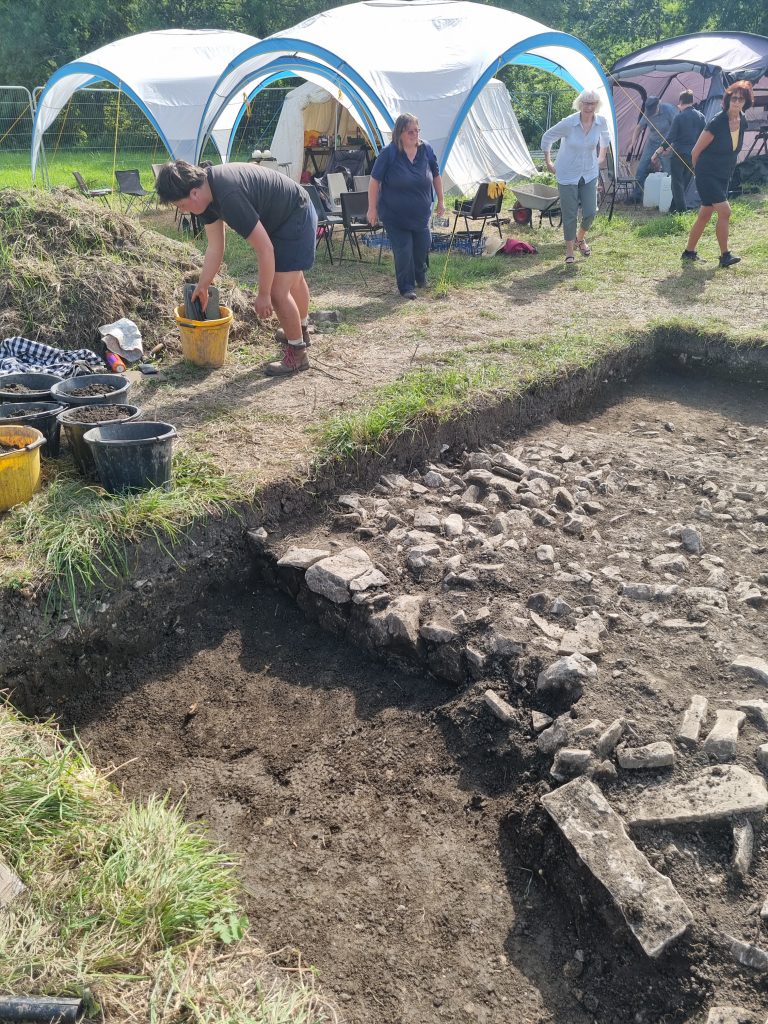
4/9/23: the cleaning of trench 1 was finally completed under very hot and humid conditions. There are one or two rough areas, but we can now progress to the next stage with this trench. Thanks to everyone for their hard work under the conditions!
There was no progress with trench 2 today – work on that will restart tomorrow. Over the weekend the bone fragments from last week were cleaned, and images seen by a human bone specialist who confirmed their ID. There are skull, knee and foot fragments – potentially from a single adult.
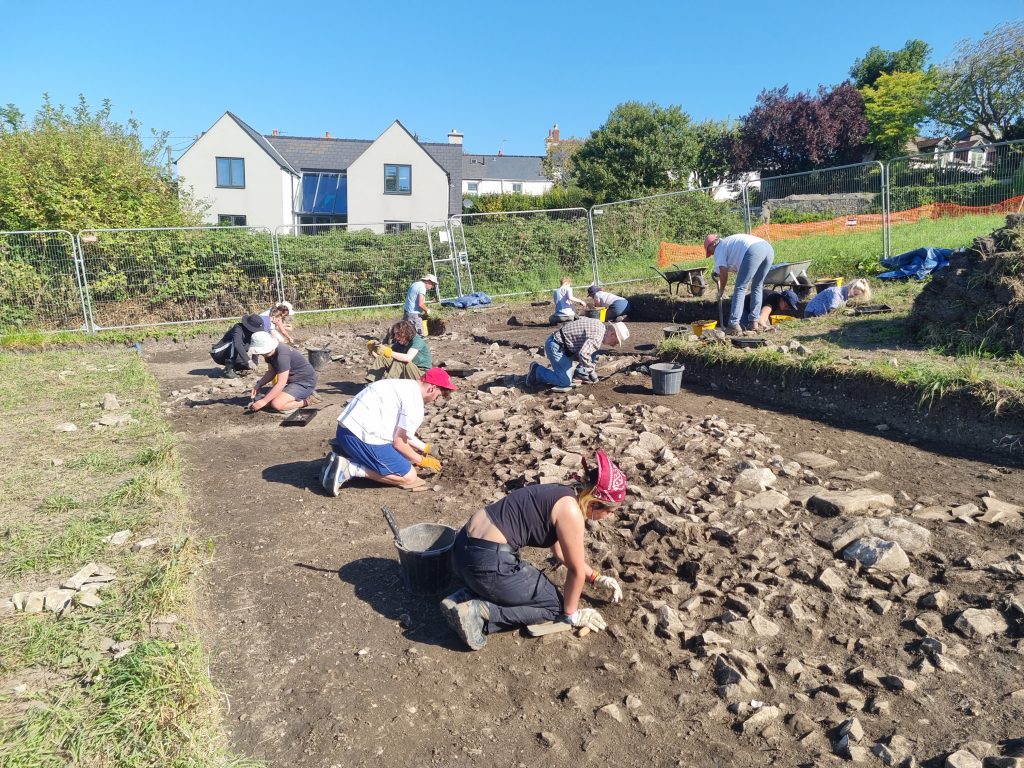
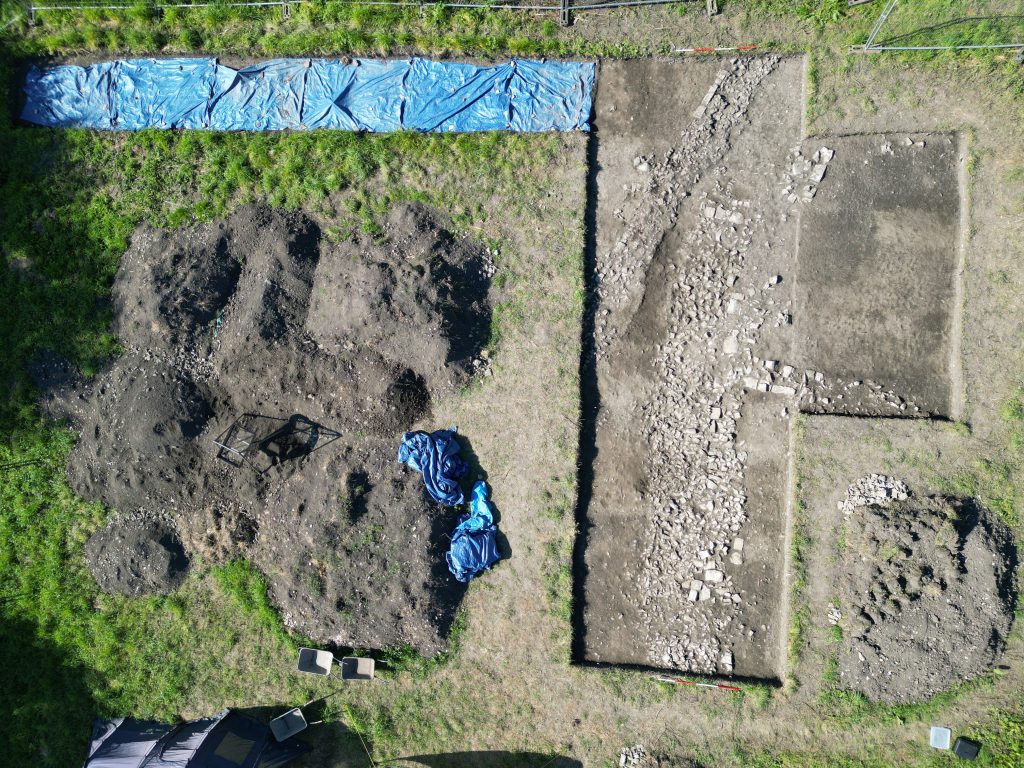
1/9/23: the cleaning of trench 1 progressed well and the end of defining the stone features is finally in sight. The whole team will be relieved when there is no more stone pile to clean!! Some structure is appearing within the pile, with a stone wall-facing being over overlain by unstructured stones spilling over it and down to the west. The deposits east of this bank produced a lovely green-glazed decorated jug fragment. I think this is a horse (despite looking more like a comedy donkey…), but it also resembles some of the Ham Green wares with hunting scenes – so could also be a deer.
Trench 2 produced a shallow, probably post-medieval gully, the fill of which seems to contain a few scraps of reworked human bone. The trench continues to yield large numbers of whelks, limpets and winkles, perhaps accompanied by a little prehistoric pottery.
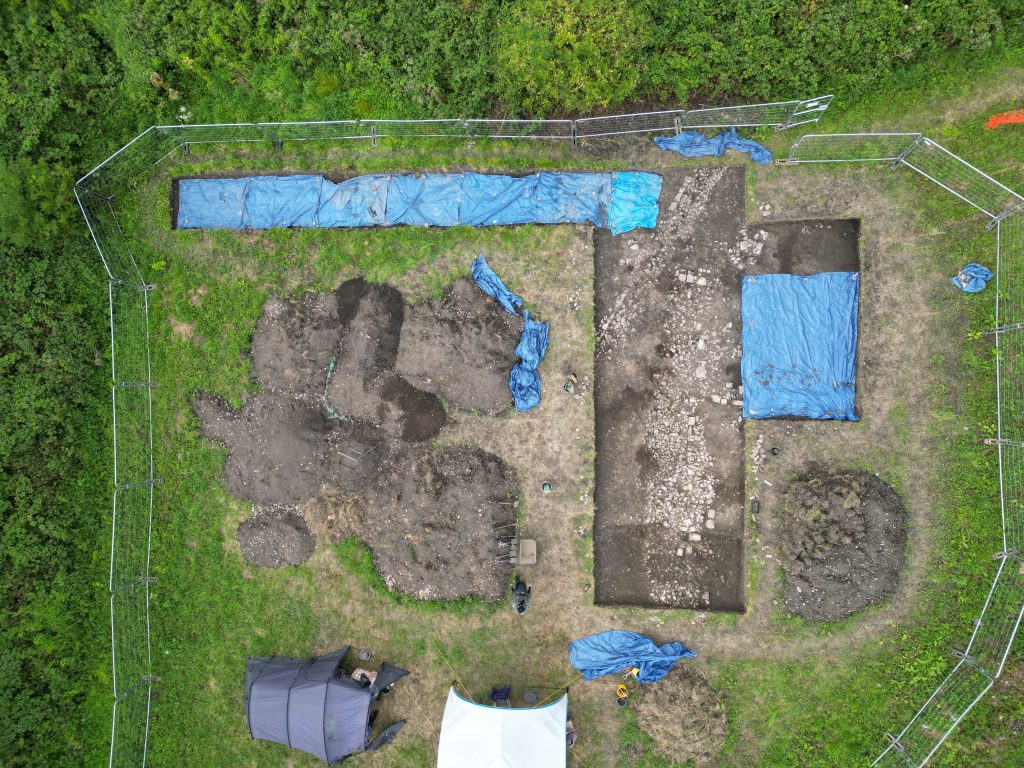
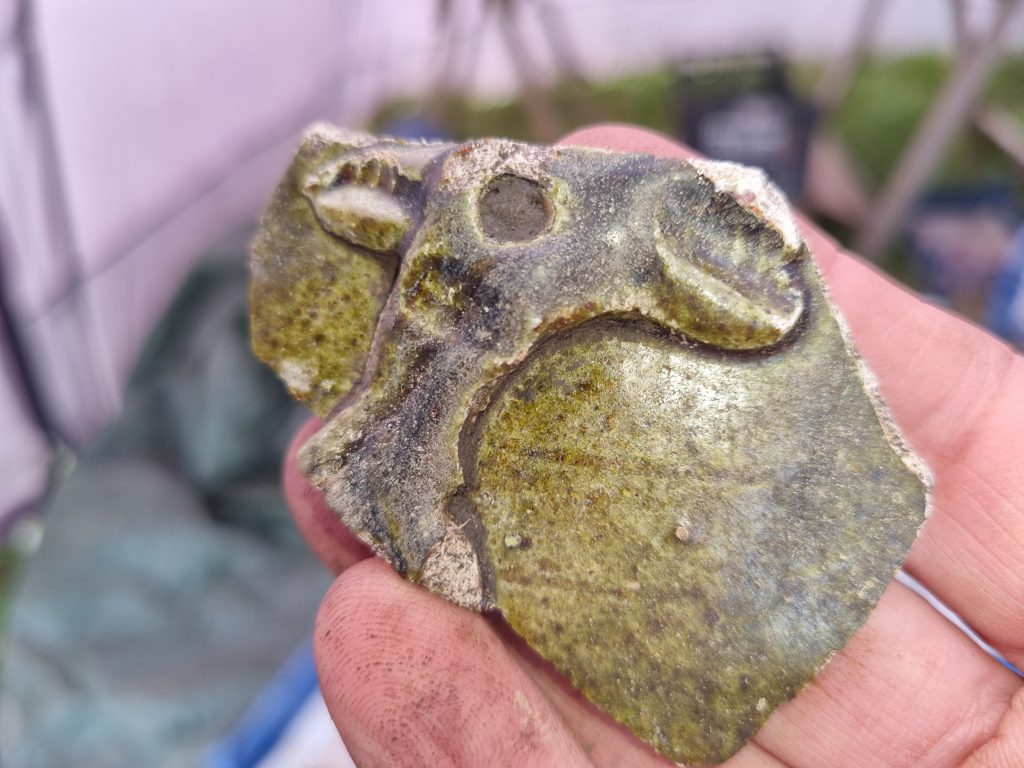
The image below shows some of the animals on 13th century vessels in Ham Green ware from near Bristol, with stags to the left (37) and a horse on the right (41). The description of the technique of applied strip decoration like our example mentions how it was applied over a decoration of horizontal grooves – just as in our piece.
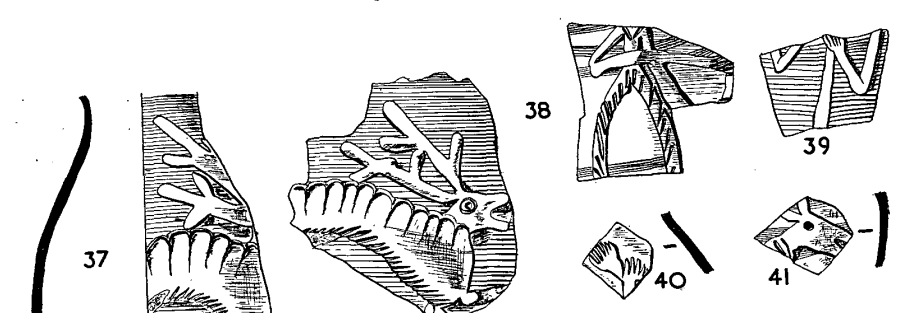
31/8/23: rained off…
30/8/23: today was a much brighter day and a lot was achieved in both trenches. The southern end of trench 1 is completed to the base of the main agricultural soil, as are some of the northern parts. The extension has had the bulk of the agricultural soils removed and awaits trowelling.
When the final clean-up of the surface was done in the south of Trench 1, substantial fragments of Roman pottery were recovered both to east (a large sherd of red ware mortarium) and west (a jar rim) of the stone bank. This raises some interesting questions about what may lie beneath…
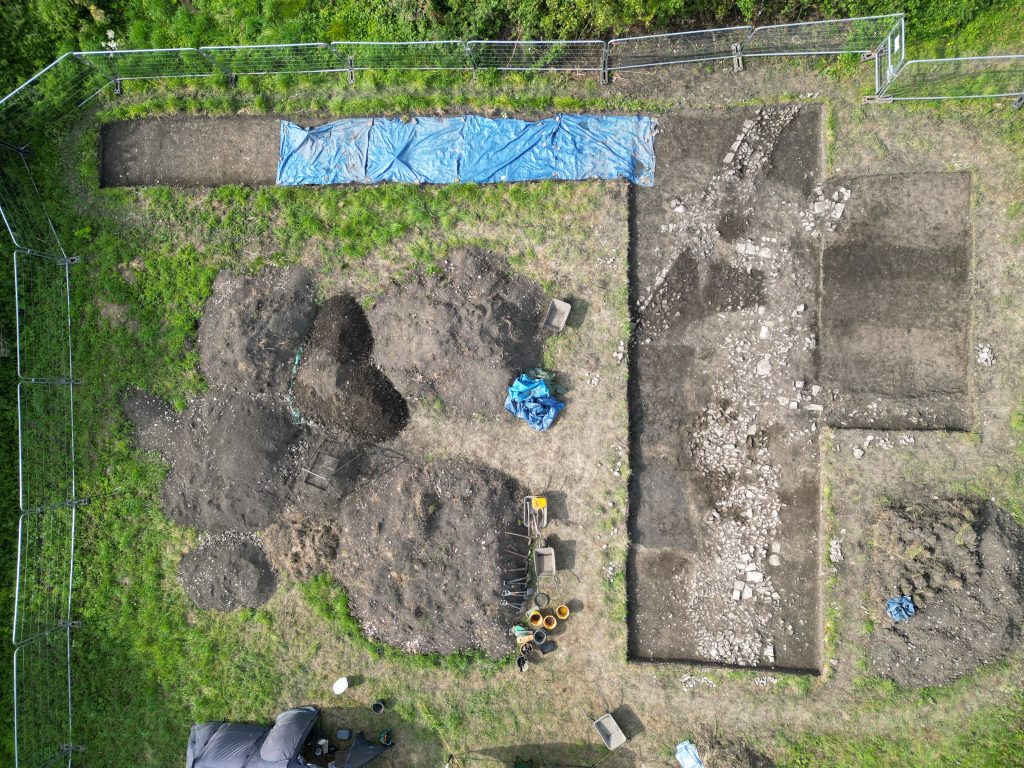
Trench 2 also progressed well, reaching a layer (possibly partly disturbed) of the natural white marl below the cultivated soils of the old allotments. The nicest find from Trench 2 was the mouthpiece (fipple) of a tin whistle or similar instrument.
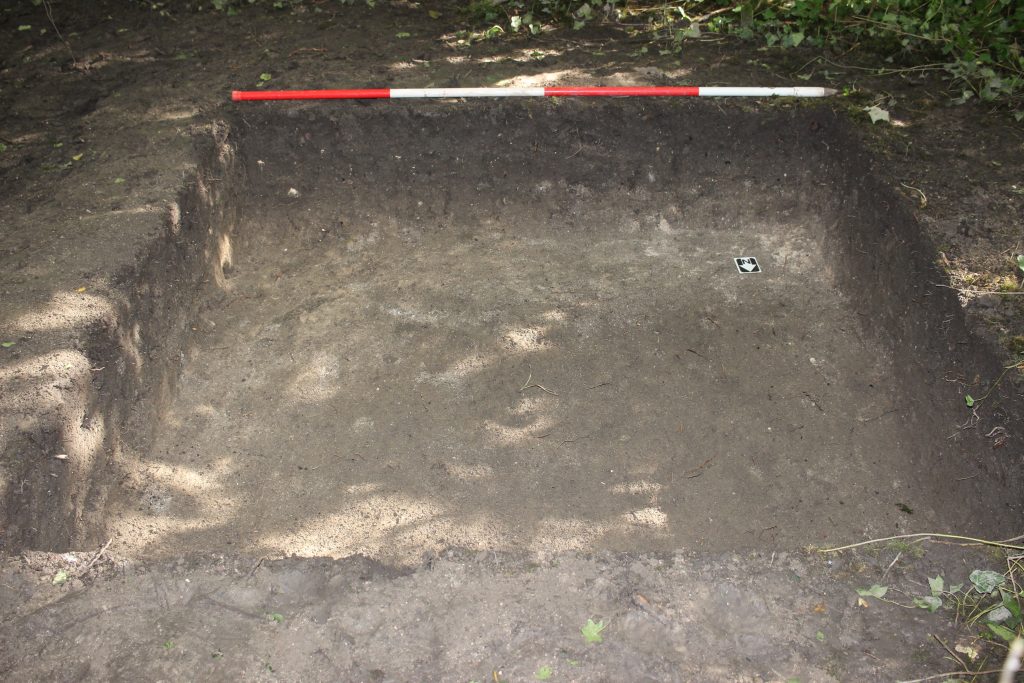
29/8/23: It was a somewhat wet day, so progress in Trench 1 was slower than desirable. The trench is really turning into two halves – half with ‘simple’ structures and half with a an array of short lengths of ‘wall’ that are not, yet, resolving into anything coherent. Time will tell…
Trench 1 also gained a new finds tent today (thank you Gail!) – so we are better prepared for the even worse weather later in the week.
Trench 2 also progressed, and is well down into the subsoil. The woods are providing some shelter from the rain here, but it is getting very soft underfoot. Geoff provided us with a lovely aerial postcard view showing the site of trench 2 as vegetable gardens in the 1920s/30s.
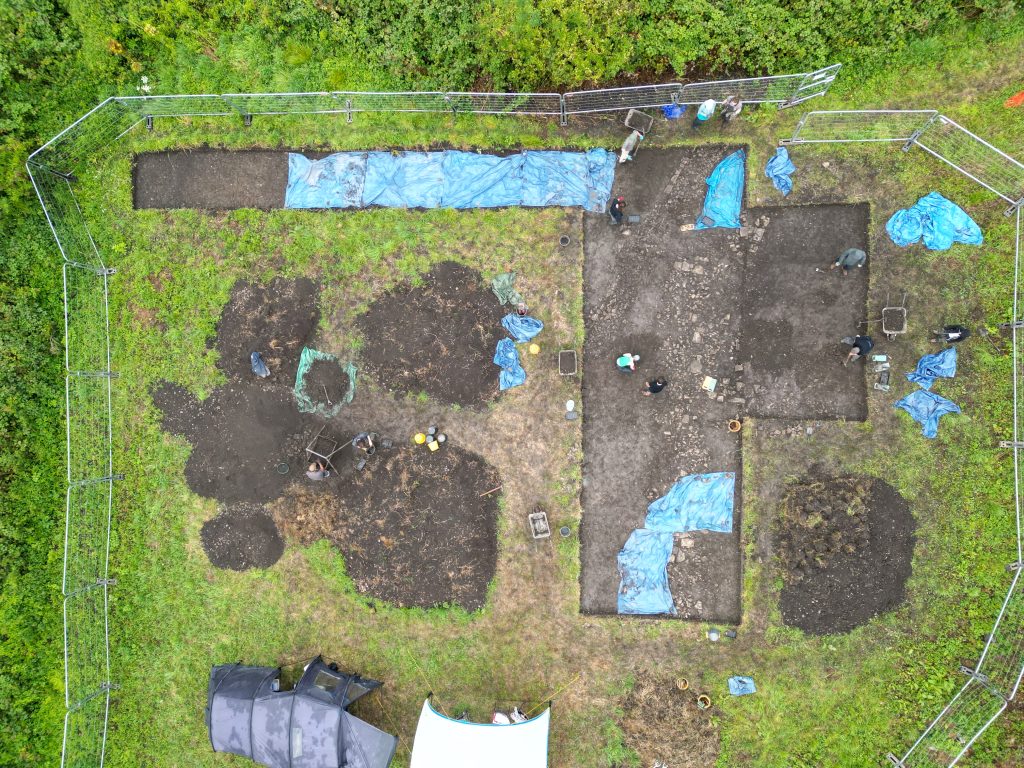
28/8/23: We only had trench 1 working today, so good progress was made with the larger team. The ‘late’ wall is now well over half cleared. A short length of wall on the north side of the extension appears to run parallel to it. The possible EW wall in the S of the extension has yet to be exposed. Clearance of cultivation soils from over the southern part of the ‘early’ wall/bank shows the stones extend further west than suspected. What appears to be a stone-packed posthole is apparently cut through the cultivation soils 4m or so from the S of the trench.
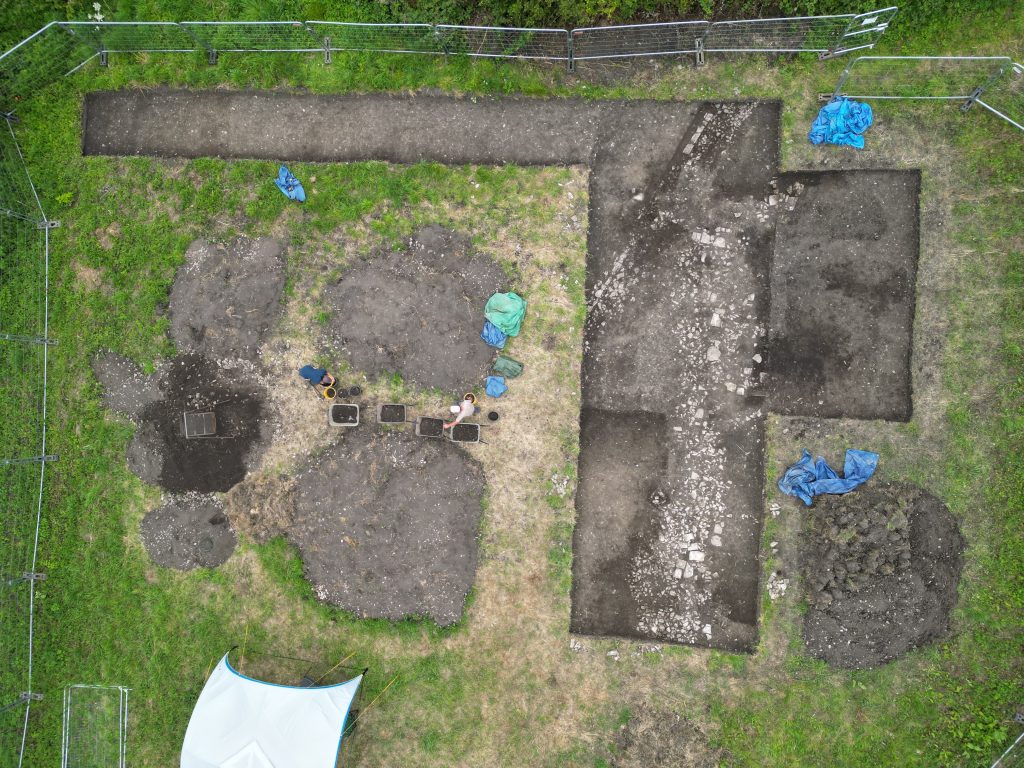
25/8/23: having considered the possibilities concerning the complexities east of the early ‘wall’, I decided the appropriate action was to open an extension to their east, so they could be examined properly. Today was a wet day anyway, so activity in trench 1 entailed an approximately 6.75m x 3.5m extension.
Across the valley, trench 2 was opened – the location under the trees avoided the worst of the rain. Interestingly, this is yielding reasonable numbers of limpet and whelk shells, just like the soils retained by the wall on the edge of the Great Ley above – and the spoil from the badger sett. The date (and location) of the primary shell middens is not known.
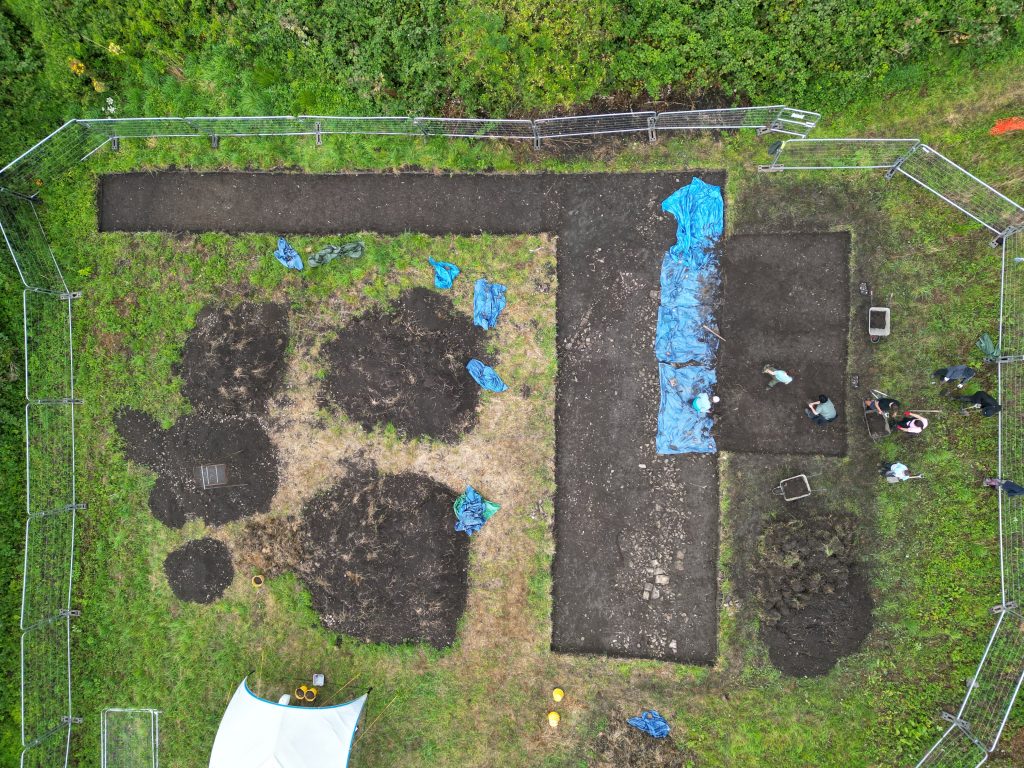
24/8/23: this was probably the last day that we have the full team working on trench 1. Both ‘walls’ are now appearing along much of their lengths. The early wall seems to stop abruptly about 3.5m from the N end of the trench, in the area of the complexities to its east.
Finds today included two late medieval to early post-medieval copper alloy lace tags (aiglets).
The report on the human bone assemblage recovered during spring 2023 also arrived today. This raises the MNI from two to four, greatly increasing the likelihood that the badger sett lies on a cemetery, rather than just isolated burials.
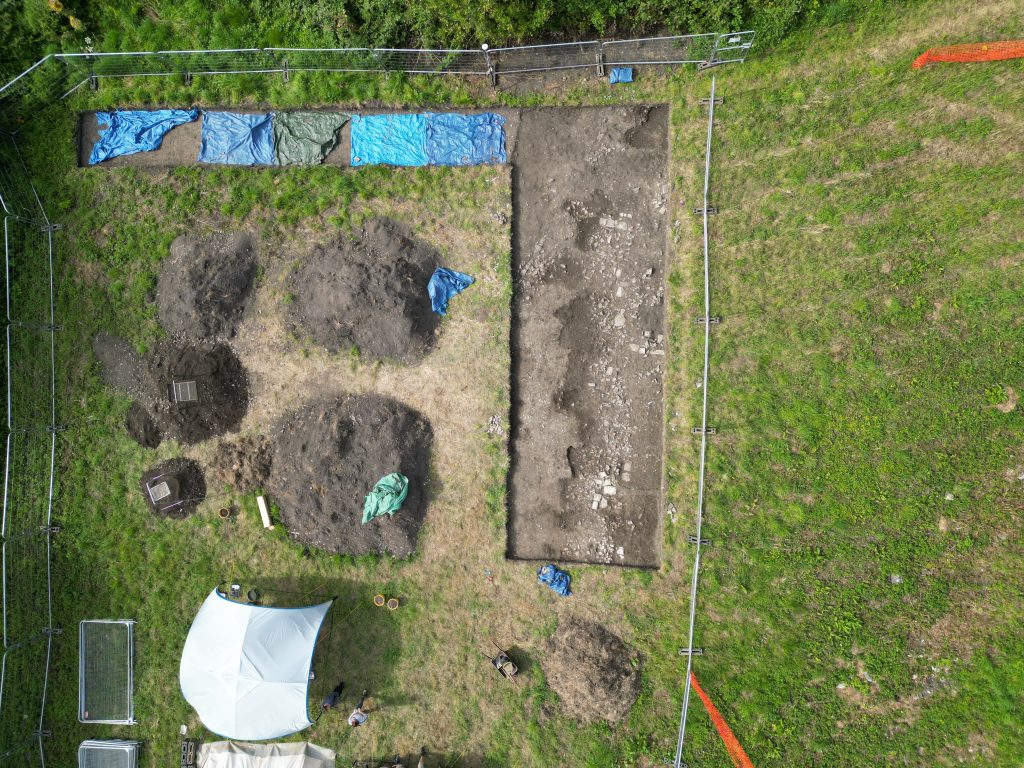
23/8/23: our first full day of archaeology saw plenty of progress made across the trench. The later wall produced a nice architectural detail in Sutton stone – possibly a component of a small compound pillar (resembling the early 13th century examples below the church tower, but smaller). The earlier wall seems to have perpendicular walls to its east, possibly indicating a small abutting building.
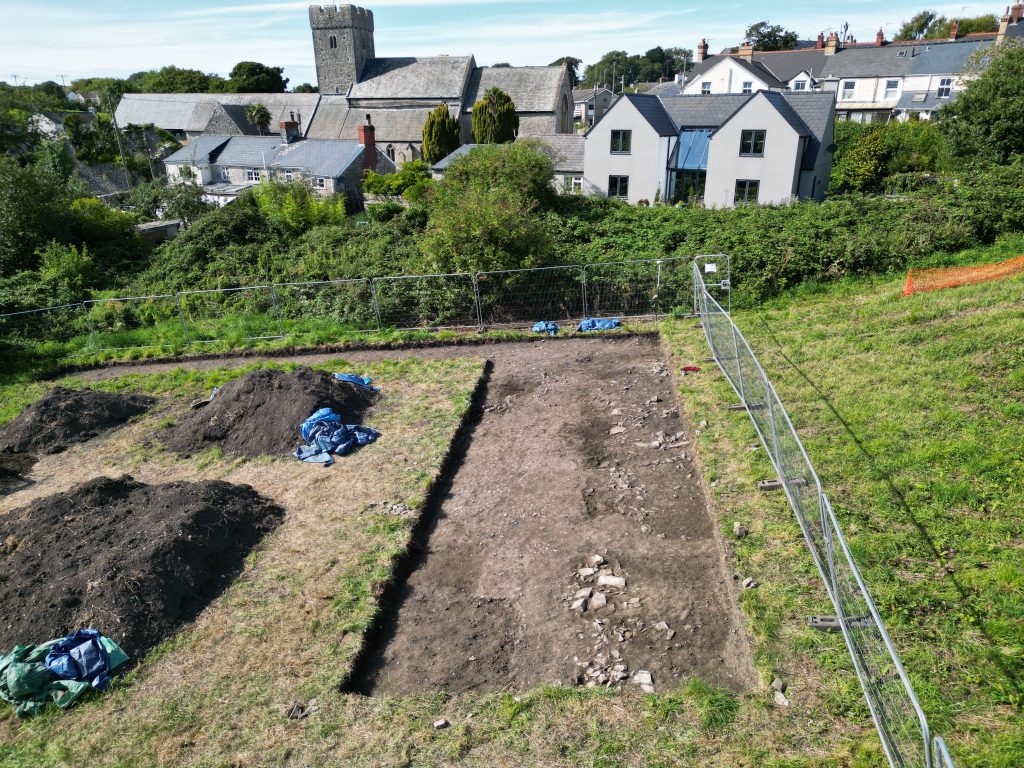
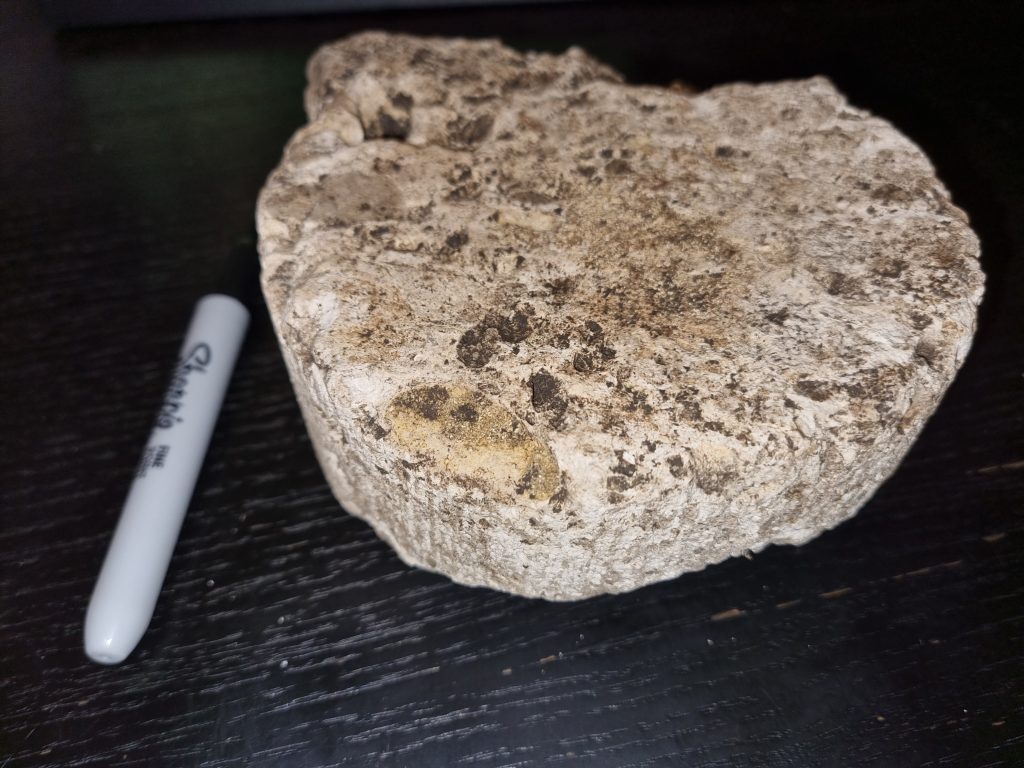
22/8/23: the delayed heras fencing was delivered in the morning, with the hiab lifting the heavy loads over a new car, next to a historical building and within centimetres of overhead cables. Then the fences (and the steel frames they are delivered in) had to be carried down to site – and the fences erected. The later part of the day involved further cleaning of the main trench, revealing more of the stone structures and producing nice amounts of late medieval pottery and a hone fragment.

21/8/23: the excavation proper started today with the Cardiff University students and volunteers. Most of the morning was spent in completing the site setup, the induction and a quick walking tour of the adjacent medieval monuments, but good progress was made in the rest of the day in cleaning the machined surface.
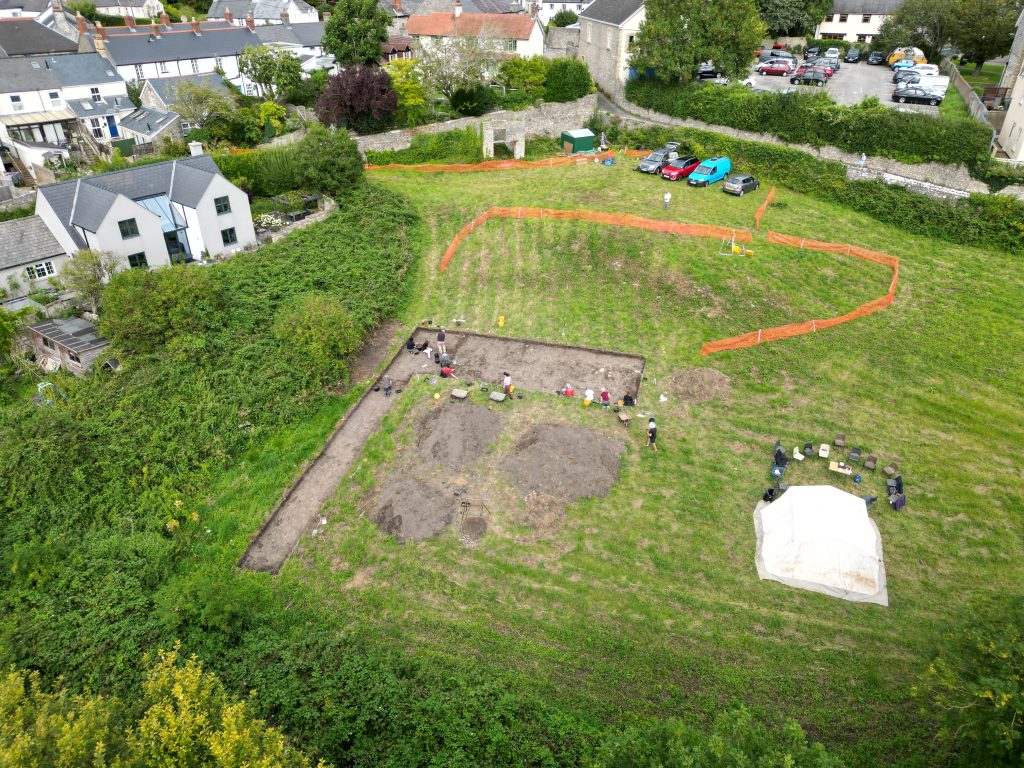
17/8/23: the main trench is now ready for Monday, with features corresponding to the geophysical anomalies showing immediately below topsoil. The volunteer team on site today spent around 12 hours on assembling the tool shed – and it still isn’t quite finished (it was complicated)…
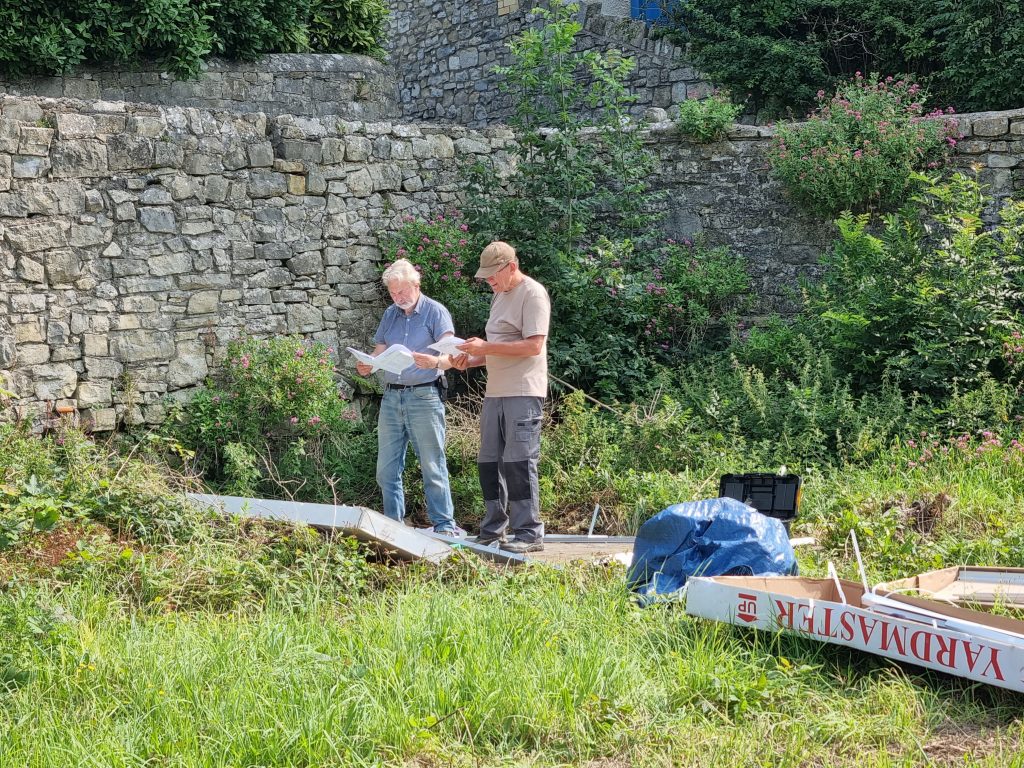
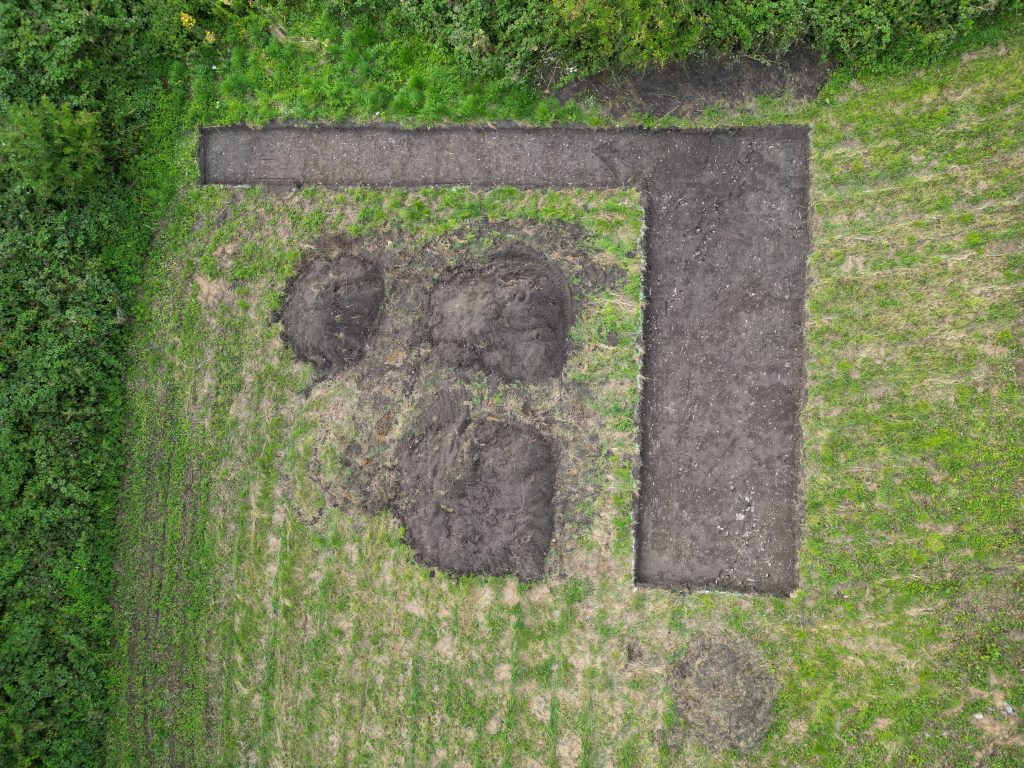
16/8/23: the main trench has been surveyed ready for machining tomorrow.
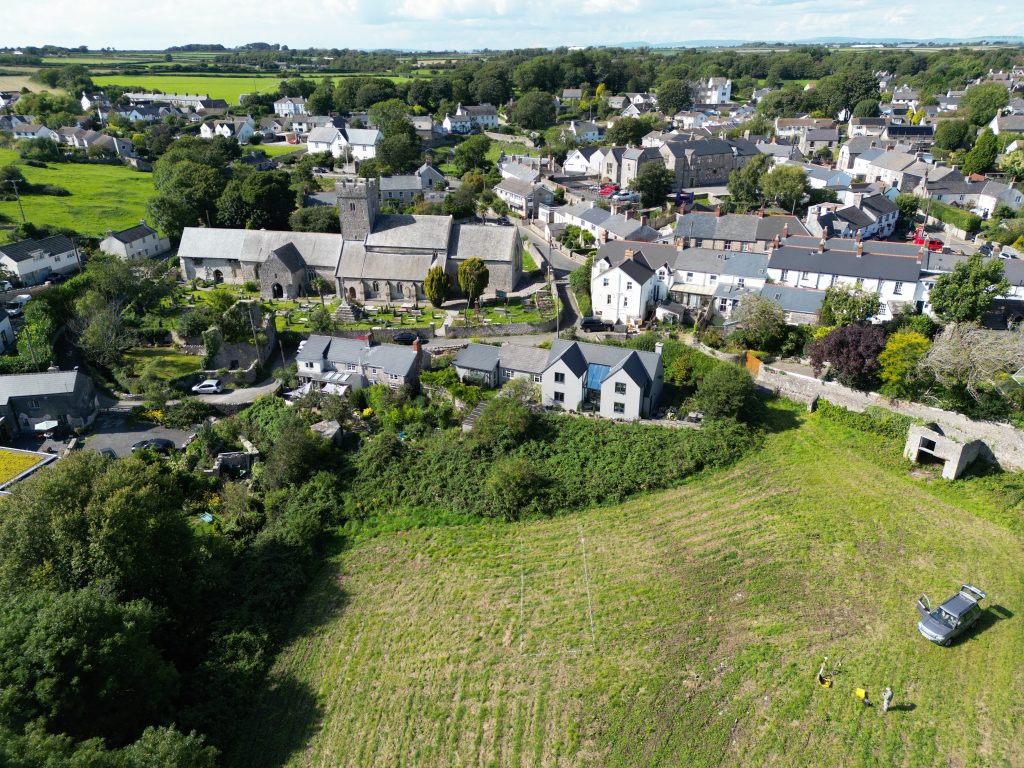
15/8/23: The GPS base station was surveyed, ready for setting out the main trench. The weather was good enough to get the drone up and acquire some images of the site in context. The earthworks of the field system in the Great Ley (with the superimposed 13th century dovecote) on the left, the location of the main trench in the field to the right, with the church beyond.
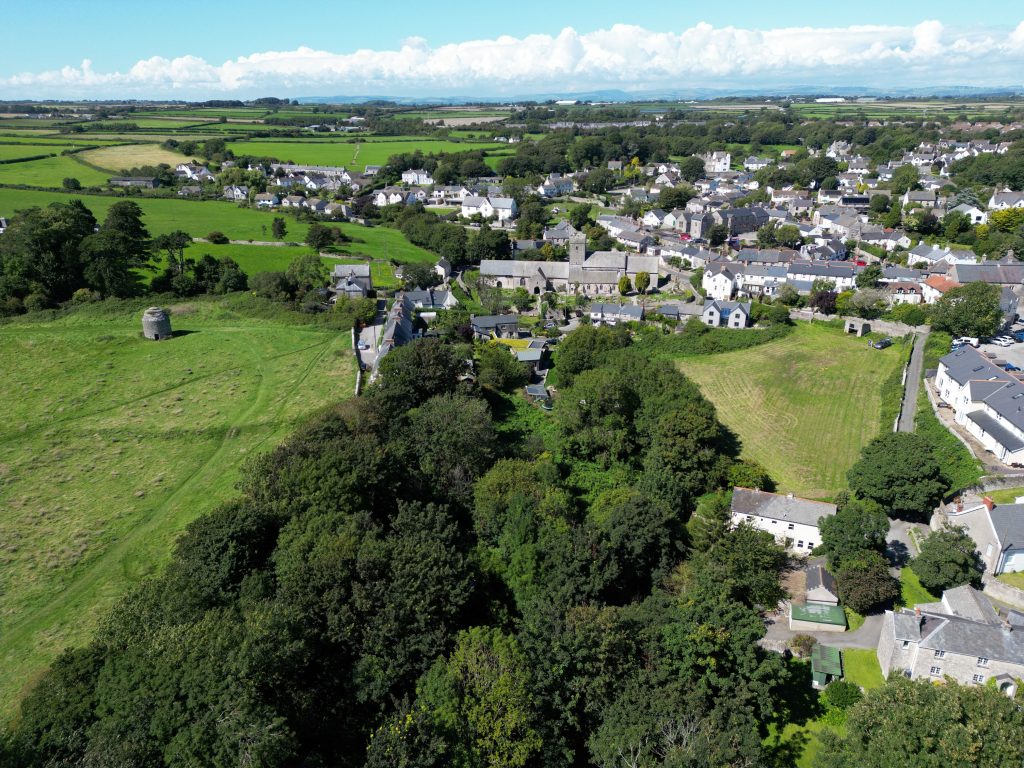
12/8/23: The vegetation in the Globe field has been mowed, ready for site setout next week.
